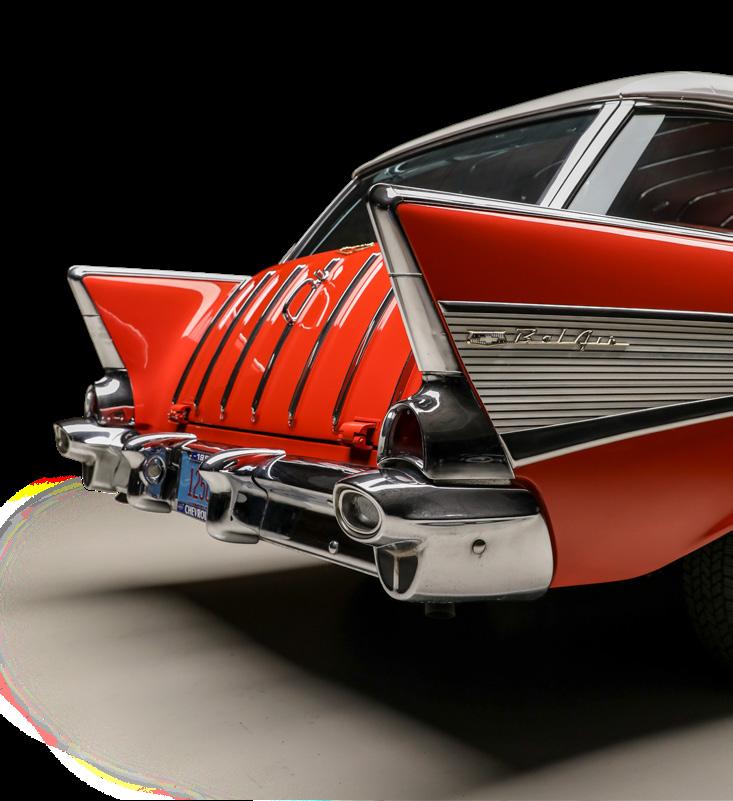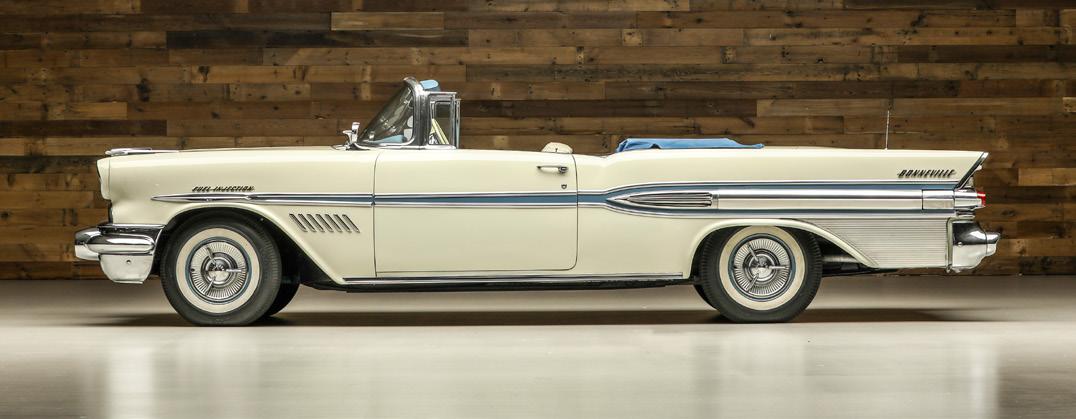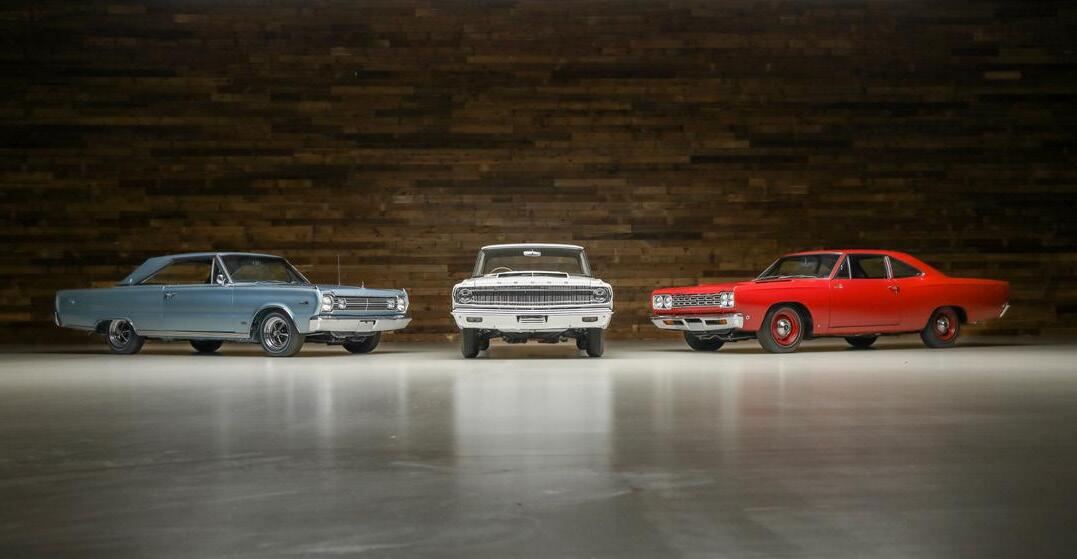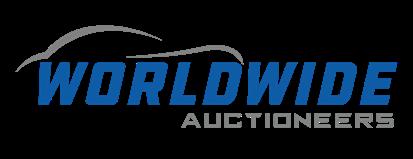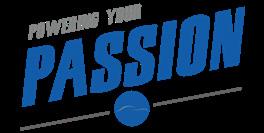Offered Entirely Without Reserve Friday, September 1 A portion of the proceeds to benefit Cars Curing Kids, a 501 (c)(3) nonprofit
















Offered Entirely Without Reserve Friday, September 1 A portion of the proceeds to benefit Cars Curing Kids, a 501 (c)(3) nonprofit
















It is a great honor for Worldwide Auctioneers to present The Tom Haag Estate Collection of fine automobiles. As a young man growing up in Madison, Wisconsin, Tom enjoyed a good life. His father had started a small, successful company, State Collection Services. After high school, young Tom really didn’t have a true direction in life, but he did have a passion for cars. One of his first jobs was working as a delivery driver for the local pharmacy, but everyone knew that the main reason he took this job was that he got to drive the pharmacist’s brand-new Corvette! In his twenties, he settled down a little and started to work for his father. One day his dad announced that he was going fishing and after that, he never came back to work. Tom grew up fast as the employees moved his workstation into his father’s recently vacated office, and he found himself being the new boss. Taking to the business world like a fish taking to water, he grew the company to over 600 employees.
While growing his family business, he also started to fill his passion for collecting cars. He enjoyed mingling with like-minded car people and was a founding member of The Eliminators Car Club of Madison. Tom helped start The Eliminators while still in high school and even at that young age, his intentions were philanthropic. More than just go-fast gear heads, Tom Haag liked to give back to the community and many of this organization’s events are fundraisers for various charities as well as an annual Tour of Care Homes around the Madison area, where members take a day caravan to senior living facilities, sharing their cars and creating fresh memories for everyone to enjoy. More recently, Tom used his big heart and love of giving back, to advance the mission and work of the Madison, Wisconsin non-profit, Cars Curing Kids. Cars Curing Kids is committed to funding and supporting causes that improve health outcomes in the lives of children in southern Wisconsin. Comprised of automotive enthusiasts passionate about children’s health care, Cars Curing Kids raises funds through automotive-centric events that share the love and joy of cars with children and adults alike. A portion of the proceeds from the sale of The Tom Haag Estate Collection will go directly to Cars Curing Kids.
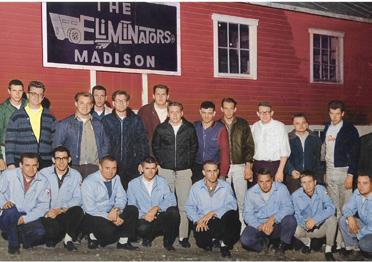
As his collection grew, he purchased a warehouse just to keep his cars. All of them were kept in perfect running order and were like family to him. Of course, he did also take time to raise a family, and his oldest son, Tim Haag, joined him in running the family business. In the late 1990s, Tom Haag met his soulmate, Tina, and she encouraged him to enjoy his cars. The storage building soon became known as Tom and Tina’s Toy Box, filled with a wonderful variety of cars, boats, and memorabilia. In 2018, Tom figured it was time to turn the reins of the business over to his son so he could spend more time where he was happiest, in his Toy Box with Tina by his side.
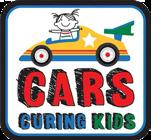
Tom was active in his pursuit of quality vintage cars and kept meticulous records. He displayed his cars at automotive events throughout the region; on special occasions, he would open up the doors to the Toy Box so that others could admire and stand in awe of these mighty machines. These treasured vehicles, ranging from a BMW Isetta to the powerful Dodge Super Stock, are being offered in Tom Haag’s memory with the hopes that the new caretakers will enjoy them just as Tom has, while confidently knowing they are also helping to support a great cause that was dear to Tom’s heart.
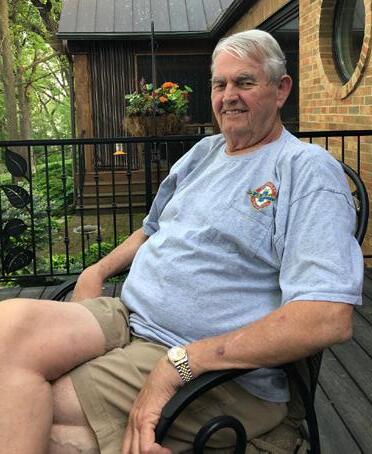
We’re building the ultimate collector car destination in the birthplace of the classic car auction business in America, right back where it all began. Experience hundreds of world-class cars live at the Auburn Auction, staged in the relaxed, convivial setting of our Auburn, Indiana headquarters in the Classic Car Capital of the World.
+1.260.925.6789 | DestinationAuburn.com

Wednesday, August 30
9am – 6pm | Auction Preview, Car Corral and Swap Meet
Thursday, August 31
9am – 6pm | Auction Preview, Car Corral and Swap Meet
12pm – 6pm | Collector Car Auction
Free Campus Parking and Free Admission to the Car Corral and Swap Meet


Friday, September 1
12pm - 9pm | Shuttle to Downtown and Museums
9am – 6pm | Auction Preview, Car Corral and Swap Meet
12pm – 6pm | Collector Car Auction
6pm | Registered Bidder and VIP Reception
Saturday, September 2
12pm - 9pm | Shuttle to Downtown and Museums
9am – 9pm | Auction Preview, Car Corral and Swap Meet
12pm – 9pm | Collector Car Auction

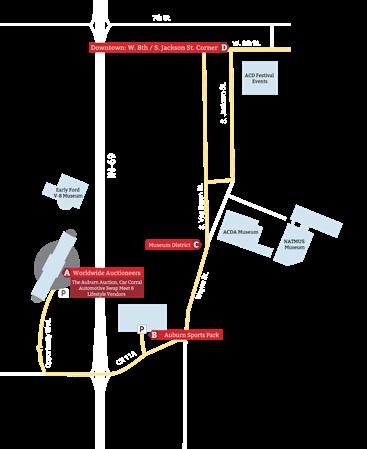
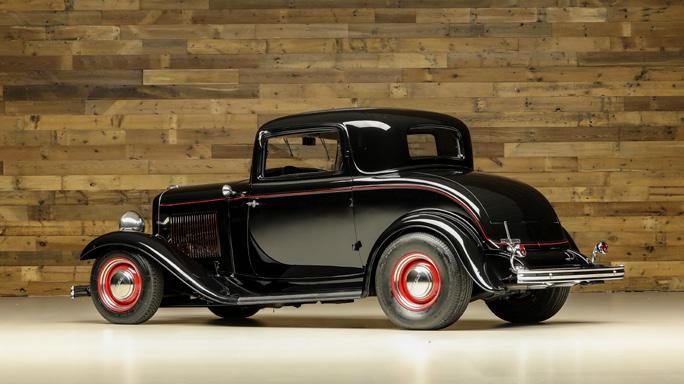
While Henry Ford was justifiably proud when he introduced the first affordable V-8 engine, his son Edsel had been working with the stylists at Ford to produce a dashing new car that was befitting of this new power. The 1932 Ford line consisted of 14 basic body styles and the Deluxe Coupe became an instant classic. While Ford referred to this model as a “two-window” coupe, Hotrodders rebranded it as the three-window coupe. More expensive than the five-window model with a delivered price of $575 compared to $490, a total of 20,506 were produced. Rodding legend Bob Labonte had an addiction to vintage tin, and it shows with the quality of construction as well as the components used on this very desirable ’32 Ford “Deuce” Coupe. Noted builder Ken Liebl undertook this project and, with an
expert’s eye, produced this iconic street rod. Finished in deep gloss black, the seats are covered in a tan Mohair fabric that is soft to the touch and comfortable to sit upon. Gauges come from Westach with the speedometer flanked by a pair of gauges mounted in the custom instrument cluster. A traditional three-spoke steering wheel guides this coupe down the road with little effort and behind the passenger seat is the release handle that opens the rumble seat allowing for two additional passengers to join in the fun. Roger Gregg performed the real magic with his expert build of the engine. Starting with a 1936 Ford long block, he bored and stroked it out to 253 cubes, filling the cylinders with Arias forged and domed pistons, adding a DeLong cam, Chevrolet exhaust valves, and a heavy-duty crankshaft, topping
This lot is available for online bidding at WorldwideAuctioneers.com
• Highly sought-after body style with all-steel construction

• Custom-built V-8 engine with Vintage Speed equipment
• Well-appointed interior with custom gauges and comfortable seating
• Participant in the Great American Race in 1990 and 1991
• Formerly of the fabled Richard Munz Collection
the engine with an Eddie Meyer aluminum intake manifold for dual carbs, plus Meyers finned aluminum heads. Custom headers were added and stainless steel was used for the dual-exhaust system that ports out under the rear bumper. With the dropped front axle, “juice” brakes, added safety and security make this a ride anyone can enjoy. Vintage steel wheels painted black are adorned with vintage Ford hubcaps and trim rings and ride on a set of Michelin XZX 165/SR 15 blackwalls to the front and Michelin XW4 P235/75R15 fat tires to the rear. It caught the eye of noted collector Richard Munz and joined his collection in Madison Wisconsin, where it was spotted by Thomas Haag, who managed to become its next caretaker. Now is the rare opportunity to drive, show and enjoy this superb build and to become a hot rod legend.


• Muscle car performance combined with Buick’s luxury
• Documented history from new
• Long list of features and extras such as air-conditioning and 8-track stereo
This lot is available for online bidding at WorldwideAuctioneers.com
VIN: 446370H197729
• Numbers matching Stage 1 455-cid V-8 engine
• Functioning dual hood scoops
Up to 1970, General Motors had imposed on its division a limited displacement to 400 cubic inches on mid-size cars. Those limitations were removed that year and each GM division, save for Cadillac, unleashed their creativity in speed and performance. Buick joined in with its new big-block 455-cubic-inch V-8, offering it in the Gran Sport models as the GS 455 package. But wait, there
• Excellent documentation with build sheet, Protect-O-Plate, warranty, and even original key punch-out tabs
was more. For those who wanted to go fast, there was the GS Stage 1 package. Modifications included a more aggressive high-lift camshaft, revised porting with bigger valves, higher-compression pistons, an enhanced cold-air induction system with functioning scoops in the hood, and a special Rochester Quadrajet four-barrel carburetor. Additionally, the suspension was beefed up with

heavy-duty springs, torque arms, and thicker antiroll bars, plus a Positraction rear axle. When put to the test by writers for Car Life magazine, they pulled a quarter mile time of 14.6 seconds, and that was with the automatic transmission. There was plenty of torque delivered by the massive 455 V-8, rated at 510 lb-ft at 2,600 RPM. One of the highlights the writers raved about was the superior drum brakes of the Stage 1, using Buick’s famed aluminum-finned drums, even in 100+ degree temperatures the brakes seemed to work better the hotter they got. In the fall of 1969, a young 20-year-old Vernon Curry walked into the showroom of Ward Buick in Stillwater, Oklahoma and he came looking for just the right car. He placed his order for a car that he could truly enjoy and that others would envy – a new Buick GS Stage 1 hardtop in Coronet Gold. For $3,382, he received a car befitting a young college student who wanted to go places, and to get there in a hurry. His car was fast with the 360 HP version of the big 455 V-8, and he didn’t want to mess around with a clutch, so he opted for an automatic transmission with the horseshoe shifter mounted atop the center console between the optional bucket seats. After placing $550 down and getting the other $2,832 financed for 24 months, he would hit the road in grand fashion. Young Mr. Curry grew older and in 1986 sold his beloved Buick to Neal Pilkington for $2,000. At that time, the car had around 43,000 miles. From documentation
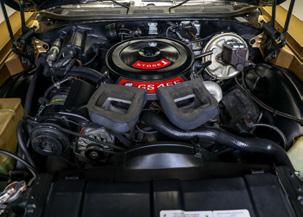
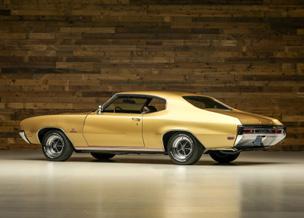
included with the car, it appears that this Buick was transferred to Michael Smith from Tulsa, Oklahoma. It would go through several other owners prior to being acquired by Thomas Haag in early 2022. This Buick appears to have been given a thorough cosmetic restoration with a superb repaint of the original Coronet Gold while retaining the original interior. Under the hood is show-car prepped. Today the car shows just over 46,600 miles and has all of the goodies young Mr. Curry had ordered with the car starting with the factory AM-FM radio and 8-track tape player, factory air-conditioning, tachometer, windshield washer and tinted glass all around, with proper carpeting which is protected by a pair of vintage “GS” rubber floor mats. The luggage compartment is fitted with a full-size spare tire and the original jack and lug wrench are neatly stored as the factory had placed them. Those GS wheels look brand new and ride on a fresh-appearing set of BFGoodrich Radial T/A tires all around. Among the documentation included with this car are an original factory build sheet, all of the car’s original financing papers for Vernon Curry, the Protect-OPlate, warranty booklets, and even the punch-out tabs for the keys, carefully stored in the little envelope provided with the car. Turnkey and ready to perform, this GS Stage 1 will make any Buick fan’s mouth water. Just press down on the accelerator, and enjoy what a muscle car should be.
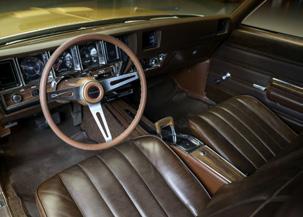
This lot is available for online bidding at WorldwideAuctioneers.com
VIN: P12484389
Engine No: P12484389
• Stock appearance and performance
• Excellent woodworking craftsmanship

• Art-Deco-inspired styling
• Mandarin Maroon paint with a new tan top
• 1 of just 5,594 produced for 1941

Before World War II, station wagons were often titled and registered as commercial vehicles, and while a few suburban families might have owned one of these wonderful utility vehicles, most were placed into money-making applications. One of the more common duties was to transport guests and their luggage from an airport or railroad depot to a hotel or guest ranch, thus earning the title “station wagon”. Plymouth touted itself as having the engine with the most horsepower to weight ratio of the low-priced three, featuring advances in suspension, comfort and appearance. For 1941, Plymouth’s interiors featured Art-Deco-inspired styling starting with the dashboard to the smart and comfortable seats. It was one of the priciest models in the Plymouth lineup for 1941 with a factory-delivered price of $995.
Finished in Mandarin Maroon, a popular color for the day, the body is constructed of oak featuring professional craftsmanship and with a golden finish under protective coatings. Featuring three rows of seating that fit seven passengers plus the driver comfortably, each seat has been covered with light beige vinyl with a stitched pattern closely replicating the original patterns. The interior floors are made of solid oak, also presented in a golden tan finish, with the front floors covered in black rubber. The spare tire is mounted to the back of the front seat and concealed under a custom-fitted matching vinyl cover that snaps into place. Protecting the top of the car is a tan vinyl material with a pebble finish which appears to have been recently installed. The all-steel wheels are fitted with original Plymouth hubcaps
and bright stainless steel trim rings that add a touch of elegance to this eye-catching beauty and ride on a vintage set of Lester 6.00” X 16” wide whitewall tires that do show a bit of age but have plenty of tread. Showing 43,325 miles on the odometer at the time of cataloging, those may well be from new. Under the hood appears to be original with the trustworthy inline six well-sorted and the original Ball & Ball carburetor, built exclusively for the Chrysler Corporation, looks to have been recently serviced. There is an unmatched charm that comes when owning and driving a vintage “woody” wagon and this Plymouth is an excellent presentation of style, looks and happy motoring.
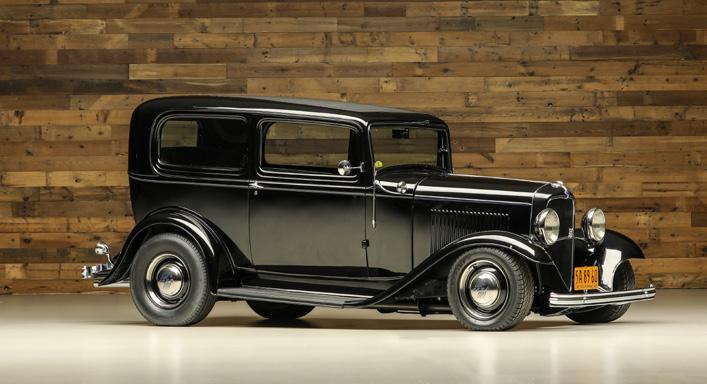
Among the most popular of the new 1932 Ford’s 14 different models was the Tudor sedan. A total of 57,930 customers purchased one of these smart-looking cars during a period of time when the American economy was in serious trouble. Henry Ford built his cars to be durable and easy to maintain, and even with wartime restrictions, many Ford V-8s saw service on the home front taking needed factory workers to and from work or serving the country in other ways.
This Tudor sedan was spared from the scrap piles during the war and in the mid-1970s was given a custom build with design and elegance that is timeless. All original steel panels were kept with the car and painted a deep and lustrous black lacquer and feature subtle blue pinstriping along the beltline of the body.
All seating surfaces as well as the door panels and headliner were restored with original style gray Mohair with the passenger front seat able to tilt forward and allow access to the spacious rear seat. Under the hood, a rebuilt 350-cid V-8, sourced from a contemporary Corvette, features a factory aluminum intake manifold with a Carter AFB four-barrel carburetor, backed up with a Turbo-Hydramatic 350 automatic transmission. A custom front suspension was designed and installed, and to the rear, a complete Jaguar independent rear suspension was installed which provides a smooth and comfortable ride with four-wheel disc brakes installed for safety and security. A set of Warrior Fluent radial 195/60R15 tires are up front with a pair of Michelin X P225/R75-15 tires to the rear, all mounted on steel wheels featuring vintage Ford hubcaps and
This lot is available for online bidding at WorldwideAuctioneers.com
• 350-cid Chevrolet V-8 engine paired with a TH350 automatic transmission
• Complete engine rebuild with receipts from Vintage Auto Repair of Phoenix, Arizona

• Jaguar front and rear suspension, disc brakes
• A menacing lowered stance, finished in black with subtle blue pinstriping
• Added air-conditioning and heat, dual exhaust, and cowl lights
• Custom engine-turned dash and original front bucket seats
trim rings which gives this sedan an awesome stance whether it is going down the road or sitting still. Showing just over 1,150 miles, which are believed to have been added since the build, this Ford has been well-maintained through the years as evidenced by a thick folder of receipts for parts and service, all of which is included with the car. Chrome work and trim present a deep reflective quality while all the glass, including the roll-down rear seat side windows, are clean and clear. A set of Stewart-Warner gauges are mounted in an engine-turned center cluster while a custom four-spoke steering wheel will make the driver of this car beam with pride. The original black lacquer does show some age-based flaws; however, it still presents quite well and deserves to be driven, shown, and enjoyed.
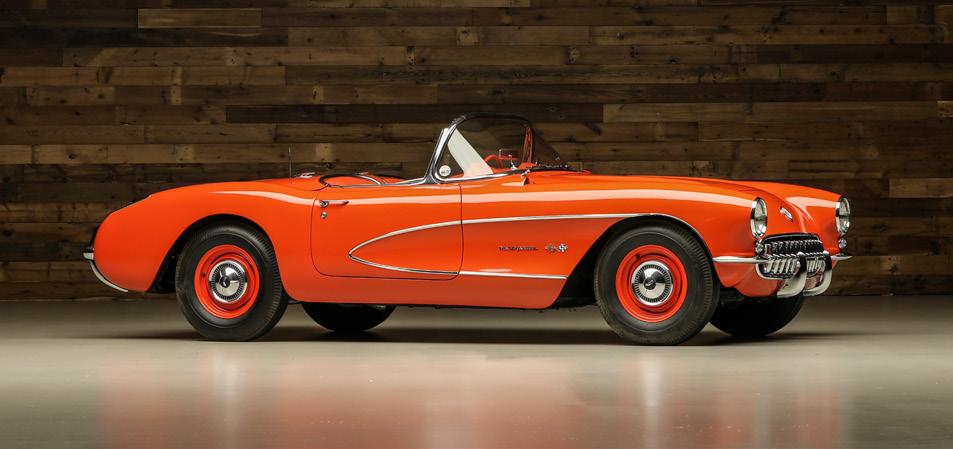
• Extensive three-year body-off-the-frame restoration with receipts and photos

• Attractive Venetian Red exterior and interior
• Two-top car, tan folding soft top and red hardtop
This lot is available for online bidding at WorldwideAuctioneers.com
VIN: E57S104406
• Rebuilt engine with upgraded fuel injection
• Borg-Warner T-10 four-speed transmission
Survival for Corvette was touch and go in the early years. 1955 almost saw the end of this wonderful experiment in the making and marketing of a true American Sports Car. Chevrolet had created a new market niche with those first machines, and it took the improvements seen with the 1956 edition that persuaded executives at GM to give the Corvette a new lease on life. Among those
• First-time offered at auction
• Many awards in this Corvette’s future
improvements were creature comforts such as exterior door handles, roll-up windows, adjustable seats, power steering as an option, a close ratio shifting setup and more powerful engine choices. With superb engineering from Zora Arkus-Duntov, mechanical upgrades promoted by Ed Cole, and eye-catching styling by Harley Earl, these three wise men breathed new life into the Corvette. Customers
responded in stronger numbers selling nearly five times as many Corvettes in 1956 with 3,467 produced. Exterior changes for 1957 were pretty much undetectable. The big news was what was happening under the hood with the introduction of the larger 283-cubic-inch V-8. It was available in five flavors starting with 220 HP in base four-barrel form, with dual four-barrel carburetors rated at 245 HP or 270 HP based on hydraulic or solid lifters respectively, and the new Rochester mechanical fuel-injection system in either 250 HP or 283 HP in either hydraulic or solid lifter form. Corvette had accomplished the goal of creating one HP per cubic inch. The end results of these improvements saw nearly an 80 percent jump in sales for the 1957s; it ensured that the breed would survive for generations to come.


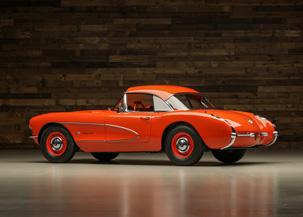
The resurrection of this 1957 'Fuelie' Corvette was truly a labor of love, devotion, and determination. Based on photos in the album that accompanies this car, Thomas Haag acquired this convertible in truly derelict condition around 2013. The chassis had some issues, the body was totally disassembled, and mechanical parts were scattered about. Turning to Madison, Wisconsin-based restorer Mitch Beyersdorf, over a three-year period he would make this road relic rise up out of the ashes like the Phoenix and impress all who see it. Starting with the chassis, any weaknesses in its condition were remedied with professional skills in patching holes and replacing those parts that had rusted or worn out beyond any hope of being salvaged. Next came ordering, preparing and installation of all the correct suspension components. With work progressing, Tom Haag had decided that money would be no object in this restoration, and only the best parts
available were used. With all the documentation provided, it’s apparent that Beyersdorf knew exactly what to order for the mechanical needs, including extensive research on the Rochester fuel injection system which is a proper 4800 series unit.
Restoring the body was like putting together a jigsaw puzzle; however, the expertise shown in the fit and finish exemplifies the high level of craftsmanship found for the entire project. With the chassis restored, and the fresh engine and transmission in place, the body was next on the list. Thoughtful and painstaking care was used to smooth out body joints using methods similar to those conducted at the St. Louis assembly plant. All panels were prepared to receive a fresh application of Venetian Red, followed by a complete interior set supplied by Al Knoch Interiors, being properly installed. All new wiring was installed, plus new glass with proper marking. No detail was too small to be overlooked with items such as proper gaskets for mounting trim items and the use of only show-quality emblems. In May 2016, the completed Corvette would join the Thomas Haag Collection in his Toy Box. The odometer currently shows just under 99,650 miles, though true miles are unknown. The engine starts on command and slips into gear as smoothly as a hot knife cuts into butter. All steel wheels with proper hubcaps, this car rides on a fresh set of Firestone Deluxe Champion black sidewall tires and tracks straight and evenly down the road. Since its restoration was completed, it appears that this beauty has been used very little. This Corvette is a show-worthy car today; it’s time to win a few awards and let it do what it was designed to do – hit the road in style.
• 1 of just 2,855 produced
• A largely original example with original wood and paint
• Classic early Ford V-8 power paired with a manual transmission
• Charming patina with attractive red wire spoke wheels

Disappointed that he was having to buy wood products from mills that he didn’t control, in the early 1920s, Henry Ford purchased the entire city of Pequaming, Michigan, a lumber town in the Upper Peninsula. Along with the town, he also picked up 500,000 acres of thickly forested land. Now he could cut down and reforest trees to provide wood framing for his Model Ts from his new Michigan Land, Lumber & Iron Company located in Menominee River Valley. In the late 1920s, these same trees started to provide birch for paneling and sturdy maple for the framework on his first Model A station wagons. Known as Iron Mountain, at first, it provided raw materials to the body companies, then later Ford hired woodworkers to make components which were shipped to Briggs and Murray, as well as Raulang in Ohio for use in the assembly of

Ford bodies. In 1934, the Model 40 V-8 Station Wagon, designated Type 860, was the highest-priced car in the Ford lineup at $660. Its body consisted of basswood, birch, and maple, all cut and trimmed at Iron Mountain, then shipped to the Murray Corporation for finishing and assembly. From there, the bodies were shipped to final assembly plants where they would be mated with the V8-powered chassis.
This “woody” from Ford is unique in that it appears to be a mostly original vehicle. There has been some maintenance performed, such as having the original soft covering of the roof painted the body color and the wheels have been refinished in red with a set of Coker Classic 6.50-RX 16 whitewall tires. On the right fender is the side-mounted spare and that tire is a vintage Firestone 6.00 X 16 whitewall, protected by a bright metal
retaining band. All three rows of seats are covered in saddle brown upholstery and the factory instruments look to have never been removed or updated. The beige body paint shows a patina of age with small chips; however, no body damage can be found. All exterior wood surfaces have been recently refinished with a high-quality lacquer coating while the inner door panels are still solid, they do show 90 years of use. Real glass is installed in all openings, with fixed panes in the rear doors and there does appear to be some minor delamination on the rear lift gate glass. This example is fitted with dual taillights and a chrome-plated horn on the front fender apron. Finding an original Ford station wagon from 1934 is a very rare occurrence and for those who love early V-8 Fords in their original state, this could be your last chance to own a piece of rolling history.
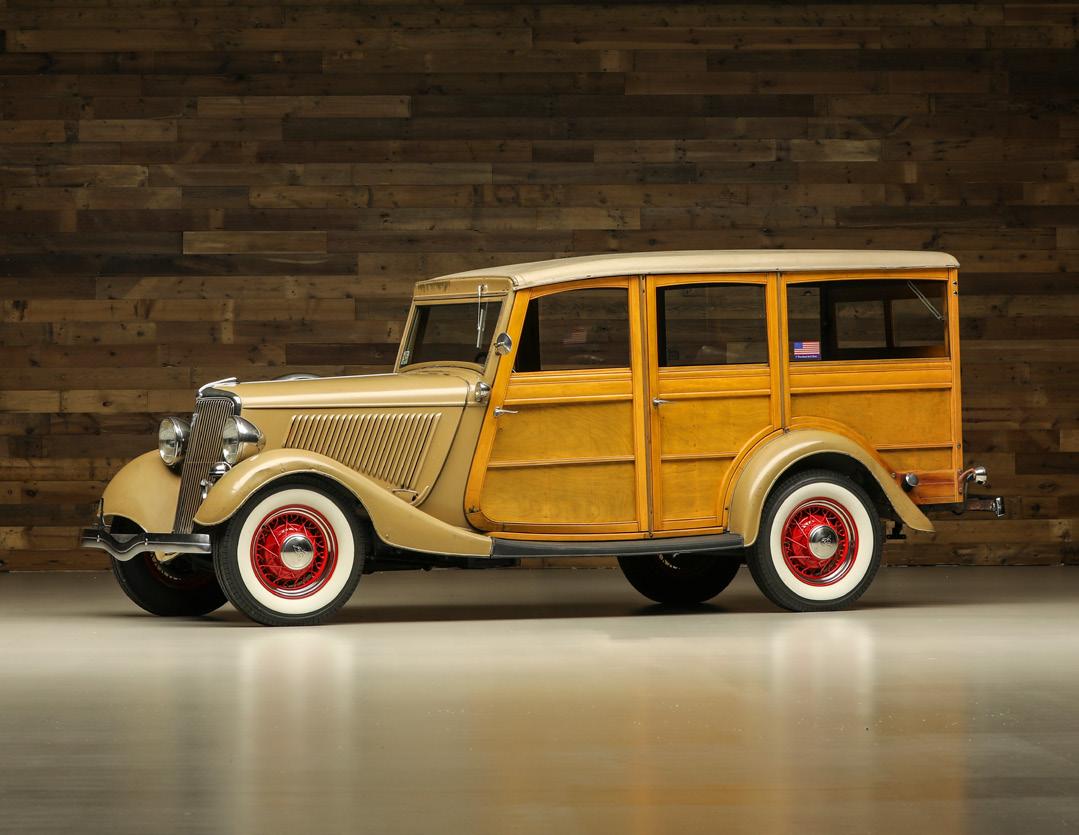
VIN: 21869K113550
• Solid body and factory interior
• Original, unrestored and ready to enjoy

• Unusual and desirable powertrain
• Ready for HPOF judging
Back in 1962, Wayne Smith from Denver, Colorado went to Burt Chevrolet in nearby Englewood to order a new family sedan, one that could be used as an everyday driver and would be capable of towing his boat. The salesman recommended that he should get the 250-HP 327 V-8 engine and that a four-speed manual transmission would be best suited for this job. Specially ordered, this car served Mr. Smith well and still sports the trailer hitch he installed to take his watercraft on those fishing expeditions. He would keep the car for many years, until the early 1980s, when he traded it to a local handyman in exchange for some repairs to his home. During Mr. Smith’s ownership, he kept track of servicing the car using a Dymo Label Maker to create clear labels which he affixed to the back side of the driver’s door, where
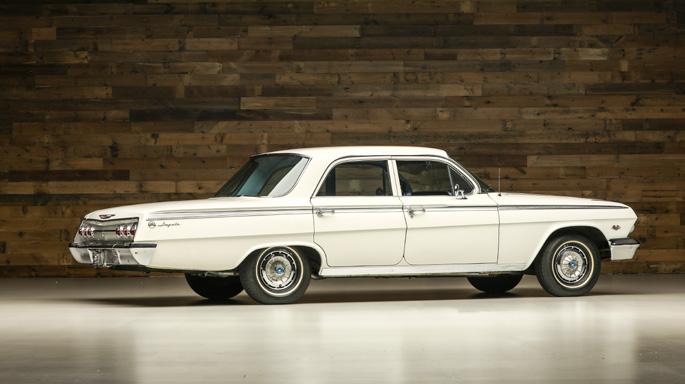
they remain to this day. When the car was traded, it included all the paperwork and the original keys. Finished in Ermine White with blue vinyl and fabric, this Impala has been well-used, but well-cared-for and preserved for the past 61 years. Accessories include the transistorized push-button radio, deluxe heater-defroster, back-up lights, factory seat belts and a two-speed windshield wiper with washer. There are no signs nor reports of any accidents, but the car does have a patina of age with minor road chips on the forward edge of the hood; the carpet and portion of the driver’s front seat do show wear and tear, but the 70,840 miles showing on the odometer do appear to be original to the car. Under its third owner’s care, a number of items were replaced including the exhaust system and heater core; the brake system
was rebuilt, and the front wheel bearings were replaced, as were the ball joints and a long list of other maintenance items. At one point, the original under-hood insulation dropped down revealing an original build sheet that was photographed. One unique feature of the car is the single-key setup with one key for the ignition, doors, glove box and trunk locks. Included with the purchase is a comprehensive album that shows many of the features of the car as well as tracing the ownership of the vehicle from new until it joined the Thomas Haag Collection. For pure vintage car enjoyment, this sharp Chevrolet sedan would make the perfect entry-level collector car, or for the seasoned veteran, a great ride to own and enjoy.


• Built 59A V-8 block with numerous upgrades
• All Henry Ford steel construction

• An interesting blend of old-school and new technology
• Concealed sound system in rumble seat
This lot is available for online bidding at WorldwideAuctioneers.com
VIN: 18687485
• Purchased from the original owner to create the build
During the 1920s, the Ford Model T looked pretty much the same with only minor changes. It was, after all, economical transportation for the masses. While there were a few styling changes with the 1928 to 1931 Model A Ford, they, too, looked pretty much the same for all four model years. However, with the introduction of the new 1932 Ford, yearly model changes were starting to take hold. One could own a 1922 Model T in 1925 and still
• Excellent combination of colors inside and out
look like the current model, but if you owned a 1932 Ford in 1934, people could tell that it wasn’t new. Ford stylist E. T. “Bob” Gregorie and his team did a wonderful job creating new and appealing designs that were contemporary and cutting-edge for the day. The 1934 Ford’s grille was chrome-plated and had grown to a pointed, slight shovel nose. Bumpers were curved and the body lines flowed. After WWII, when the hot-rodding craze was getting
underway, many felt the 1934 Ford was the perfect starting point for their dream car. For years, Billy Herbert had been trying to buy the unrestored Model 40 roadster from its original owner in Bisbee, Arizona. It was a tired car, but it still ran, and it was the owner’s pride and joy. Finally in 1985, after 51 years of ownership, the car was purchased. Immediately Billy took the car to Charlie Hall who was a craftsman with metal. Being a Southwest car, all of the sheet metal had survived, so with a little hammering and pounding all the dings were straightened and creases flattened out. Next, Henry Ford’s original metal panels were sanded and primed and Hall applied Dupont Base/Clear “Polo Green” to the body. The same care was taken for the original fenders which received a fresh coat of gloss black, after which the body was decorated with finely applied gold pinstriping. While the body was being brought back to life, the chassis, including the rear axle, was stripped and painted gloss black. Up front, a tubular dropped axle was utilized and a set of vintage 1940 Ford brake backing plates were installed so that hydraulics could replace the mechanical brakes. A genuine NOS 1934 Ford grille was located, as were a pair of side running boards, to help bring this roadster back together. Discarding the original engine for a later 59A block, the cylinders were ported and polished and a Mercury crank was

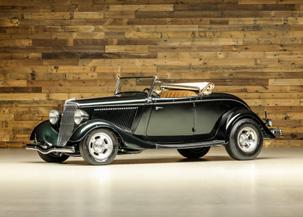
added. Custom-made aluminum heads produced by the legendary Kong Jackson were created just for this car and topping off the build was a Thickstun aluminum intake manifold. Ensuring easy starts was the MSD electronic ignition system along with a set of vintage Fenton headers located and bolted into place finishing off with a pair of Stromberg 97 carbs. A set of original Halibrand magnesium knock-off wheels were located and fitted with Michelin tires all around 165 SR/15” up front and 235 R/15” to the rear. Seating surfaces were supplied by LeBaron & Bonney with brown leather, including the fold-down rumble seat and a restored set of instruments was installed in the professionally woodgrain dashboard. This car was acquired by the Haag Collection in 2011 after it had been in storage for about 12 years. It was carefully reawakened and made roadworthy. According to the odometer, it appears to have been driven just under 4,200 very careful road miles. This is one car that the more you study it, the more you will come to appreciate little things like the pop-out windshield, the clear glass wind wings, the feel and fit of the door panels, or just the stance of the car. Under the hood is an awesome sight, especially those massive Kong aluminum heads and the dual carb setup. This is one of the most attractive roadster rods we have ever offered and one that you will be proud to own, drive and display.
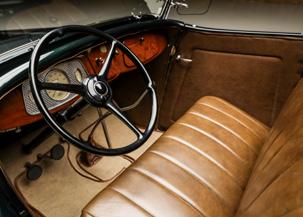
• Beautiful and correct rotisserie restoration documented by receipts

• Shelby American Automobile Club multiple award recipient
• Listed in the Shelby American World Registry
This lot is available for online bidding at WorldwideAuctioneers.com
VIN: 9F02M480738
• Original factory broadcast forms and inspection sheet
• Finished in its correct and rare color of Silver Jade
When Carroll Shelby’s Mustang-based GT350 was introduced in 1965, it was big news. While Ford offered a 289-cid V-8 with 271 HP, Shelby coaxed another 35 horses from that same small block engine. On top of that, unique aerodynamic body parts, suspension upgrades, and other touches set these cars apart from the basic Mustang. 1966 saw several improvements and an
• Original drivetrain; power steering, power brakes, roll bar, and shoulder harness
order for 1,000 Hertz Rent-A-Car versions. When Ford revised the Mustang in 1967, more improvements and models were offered and, in 1968, even more with higher horsepower and a regular production convertible model. By 1968, Shelby had turned over production of the cars bearing his name to Ford but still had his hand in the design and marketing. For 1969, the Shelby had a look

that was unmistakably its own. This year the GT350 employed the Windsor 351 V-8 engine topped by a fuel-thirsty four-barrel carburetor and, while the horsepower was officially rated at 290, those were conservative figures.
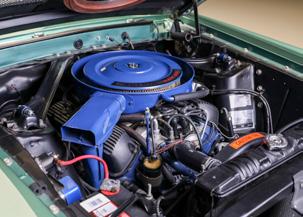
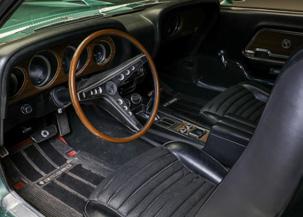
This beautiful example was produced at Ford’s Dearborn assembly plant during the early part of February 1969, and was delivered new by Fuller Ford Inc. of Cincinnati, Ohio, to its first owner Russell Marsh. Driven and enjoyed for many years, in 1983 it was sold to Pam and Steve Elliott. Under their guidance the car was reported to have been given a full rotisserie restoration at which time the interior was freshened, all bodywork repaired or replaced as needed and all mechanical systems brought back up to factory standards. In August 1984, this Shelby was being offered for sale in Hemmings Motor News. By 2003, it was under the ownership of Lynn and Cindy Stewart, and in May 2003, they had it judged at an SCCA event where it was awarded a Silver Award, a feat this couple repeated two years later. Under their ownership, they upgraded the clock with a quartz movement and receipts show other maintenance was conducted as needed. In June 2011, this fastback beauty was acquired by Thomas Haag for his collection. A number of minor repairs
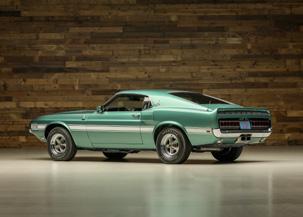
were carried out by trusted restoration specialist Mitch Beyersdorf of Madison, Wisconsin. Today this incredible Shelby is ready for show or go.
Finished in its original Silver Jade paint with the black Clarion Knit covered bucket seats, it is fast and comfortable. Under the hood, the original Windsor 351 V-8 stands ready to go, backed up by the FMX automatic transmission paired with the 3.25:1 Traction-Lock rear axle. In addition to all the Shelby and Mustang standard features such as the 140 MPH speedometer, this car is equipped with the original AM radio, fold-down Sport Deck rear seat, and rides on its original Magnum 500 wheels fitted with Goodyear Polyglas F70 X 15” tires. The odometer shows 44,250 miles and, according to documents included, less than 600 miles have been added over the past 18 years. Other items included in the sale are two original broadcast forms from the Dearborn assembly plant plus the original factory inspection card, copies of the original invoice from Fuller Ford, and an original 1969 Shelby sales brochure. It was near the end of the era when American racing legend Carroll Shelby teamed up with Ford Motor Company to create this legendary automobile, and this is your chance to grab a piece of the legacy and have fun doing it too.
• America’s first pickup with styling for suburbia
• Beautifully restored and presented

• Rare power steering and power brakes
• Body-off-the-frame restoration
This lot is available for online bidding at WorldwideAuctioneers.com
VIN: V3A56K012818
• V-8 power with standard transmission
For 1955, Chevrolet passenger cars were all-new – new styling, new V-8 engines, new comfort and simply put, a lot of wow. It only made sense that owners of Chevrolet cars would look to the bowtie logo for any commercial needs that might arise. Since 1947, Chevrolet had dominated the light-duty truck market with their Advance-Design pickups, but for 1955, that look, even though updated, was beginning to get a bit dated. In the Spring
of 1955, Chevy fans got quite a surprise when the new “Task Force” generation line of trucks was released, sharing a passenger-carderived look that was unlike any other truck ever seen in production. To spotlight these new rigs, a showpiece had to be created. Just as the Corvette would bring in foot traffic at the dealerships, a new, smart, and attractive pickup was needed, thus was born the Cameo. This was America’s first luxury pickup, with attractive comfortable
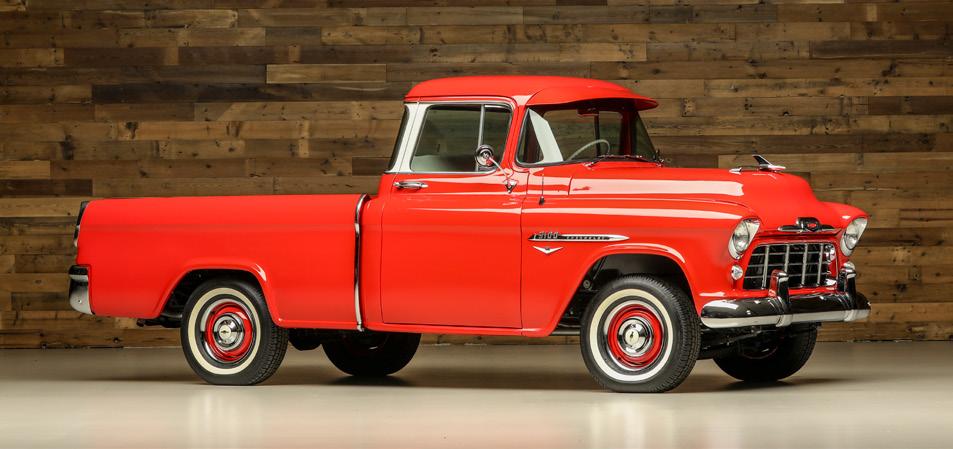
“Nu-Flex” seats, better insulation in the “Flite-Ride” cabin, and coordinating with the sleek new styling up front, and the use of fiberglass side panels for the standard-size pickup bed. These were pricey pickups and for 1956, the second year of Cameo, just 1,452 units were produced. While the trustworthy Chevrolet Six was available as standard equipment for a few dollars more, a small-block V-8 was now available. These trucks were the talk of the town. This beautiful 1956 Cameo received a complete nut-and-bolt restoration around 2014 and has traveled more than 560 miles since. Purchased by Thomas Haag, it was treated like a princess, always stored in climate-controlled environments, and maintained in ready-to-go condition. Finished in two-tone Cardinal Red and India Ivory on the rear pillars of the cab, this is a stunning truck. Under the hood, which is fitted with the rarely seen chromeplated hood ornament, the engine bay and clean and well-detailed with the inner panels finished in black with a satin finish, and the V-8 properly detailed and topped off with an original oil bath air-cleaner. Rarely seen on pickups of this era, even
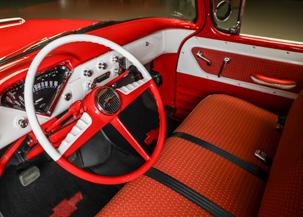
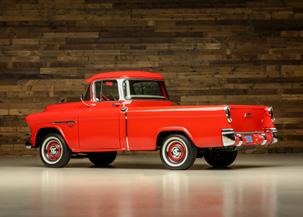
the luxurious Cameos, are both power steering and power brakes, something found in only a very small percentage of trucks. One change during the restoration was the installation of a 3.38:1 rear axle to give this truck better roadability over the stock 3.90:1. The refinished steel wheels are fitted with proper hubcaps and bright finished trim rings and ride on a set of American Classic P235/75R15 radial whitewall tires. All chrome trim, plus the front and rear bumpers, has a deep reflective finish and the body panel alignment is better than when it was new. The interior is finished with proper white vinyl bolsters and red star cloth, completed with a padded headliner and properly trimmed door panels. A modern “Retro” AM-FM radio has been installed in the original opening. The restored pickup bed was fitted with new oak planks left in their natural state to show off some of nature’s finest work. A beautiful example that will be fresh to the show circuit, this is the type of truck that will win a few trophies and awards and should be driven and enjoyed.
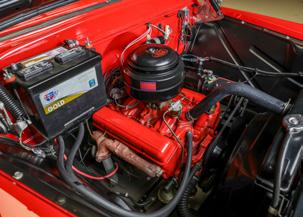

F or those that know vintage hot rods, the first thing their eyes spot when they see this roadster are the legendary Ardun heads mounted on the Mercury block and accompanied by an Austin-Ardun special intake manifold designed to accommodate a trio of Stromberg 97 carburetors. Brothers Zora and Yura Arkus-Duntov operated a small shop in New York when they were connected with Ford to help design a modification to provide more power for the flathead V-8 used in commercial vehicles. They developed an overhead valve configuration which provided a hemispherical combustion chamber. While this new head design did what Ford wanted it to do, the company engineers were already working on prototype OHV engines and plans for full-scale production failed to materialize. The
brothers advertised these miraculous hemi-heads and sold a few of these conversions, estimated to be no more than 200 to 250 sets. A few lucky early performance masters discovered these heads and, for those lucky enough to find a set of original Ardun heads, they became legends wherever horsepower was displayed. Reportedly, Richard Munz connected with Rod Palmer, founder of Arizona Street Rod, and the fabrication of this 1932 roadster was initiated. Palmer created his own chassis and bodies with the same exacting quality that Henry Ford’s engineers had in the original design. The engine was bored out to 286 cubic inches, and fitted with 10-to-1 Venolia Pistons, a 4.125” Crank, and a long list of other features before the dual crowns of original Ardun heads were mounted to the block. While the chassis is finished
This lot is available for online bidding at WorldwideAuctioneers.com
VIN: 18139077
• Old-school build with exceptional components
• Modified 286-cid Mercury V-8 engine with custom-built Ardun heads
• Built by Rod Palmer of Arizona Street Rods
• Formerly of the Richard Munz Collection
• Accompanied by a soft top and a complete list of engine upgrades
in gloss black, the body of this roadster is simple matte black. With a tight body, room for driver and passenger is snug but enjoyable; driving this car will take you back to the days when you had to really love the road. Henry Ford’s original front and rear transverse leaf springs provide most of the “bounce” for this ride, with rebuilt lever-type shock absorbers on all four corners. Pressed steel wheels fitted with Mercury hubcaps minus the bright trim rings are riding on Firestone tires, 4.50-4.75” X 16” up front and wider 7.50” X 16 blackwalls to the rear. Little touches such as the “8-Ball” shifter add to the vintage feel and look. Showing just over 2,900 miles on the odometer, this roadster has barely been broken in; it needs to be driven and if you are a hot-rodder at heart, it needs you behind the wheel.


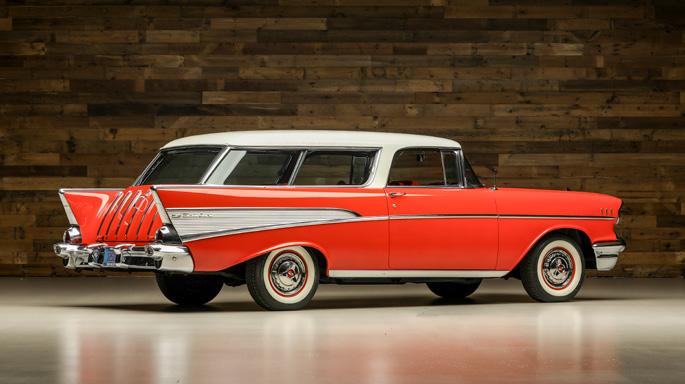
First shown as part of GM’s 1954 Motorama at the Waldorf Astoria, Chevrolet’s dramatic Nomad station wagon, based on the sporty Corvette, was a major sensation. The following year, the Nomad was brought to the market as a full-size two-door hardtop station wagon. While the production numbers were modest, the Nomad did build showroom traffic and added to the flair of Chevrolet’s new styling. Its hallmark was the gracefully forward-slanted B-pillar, which was echoed in the rear contour, along with several vertical chrome strips added to the rear tailgate, designed by Carl Renner under the direction of the legendary Harley Earl. For 1957, Bel Air side trim was used including the distinctive rear quarter anodized aluminum flash and a rear wheel opening that more closely resembled the regular passenger
cars. For many, it was the epitome of design and function.
This beautiful example hails from California and was assembled at the Los Angeles area Van Nuys facility. While the early history of this stunning wagon has been lost, copies of the receipts on hand show the Nomad was treated to a full restoration during the early 1990s. Today it is finished in Matador Red with India Ivory two-toning while the interior features proper grain vinyl bolsters with black and red “cloud” fabric inserts in the factory saddle-stitch pattern, complemented with matching door panels and red chain vinyl headliner and sun visors. Optional equipment includes the Wonderbar AM radio, electric clock, power steering and power brakes, dual exhaust, back-up lights, EZ-Eye tinted glass with blue-banded
This lot is available for online bidding at WorldwideAuctioneers.com
VIN: VC57L157221
• Mid-century modern family transportation
• Superb design, style, power and desirability
• Iconic and timeless beauty
• Well-documented with receipts and detailed photos
windshield, full wheel covers with the simulated knock-off ornaments, and wide whitewall tires. The Super Turbo-Fire V-8 engine is beautifully detailed as is the entire engine compartment. The odometer shows under 5,900 miles, which is probably all this car has been driven in the 30 years since its restoration. While this Nomad was born in Southern California, it did live many years of its life in the dry climate of Arizona where it was well-protected as evidenced by the pristine appearance this car presents today. All chrome work is deep and reflective, the glass is without flaws and the bodywork appears to be at or above factory specifications. Nomads were among the first American-built cars from the 1950s to be sought-after by enthusiasts and collectors, and this example is one of the finest.

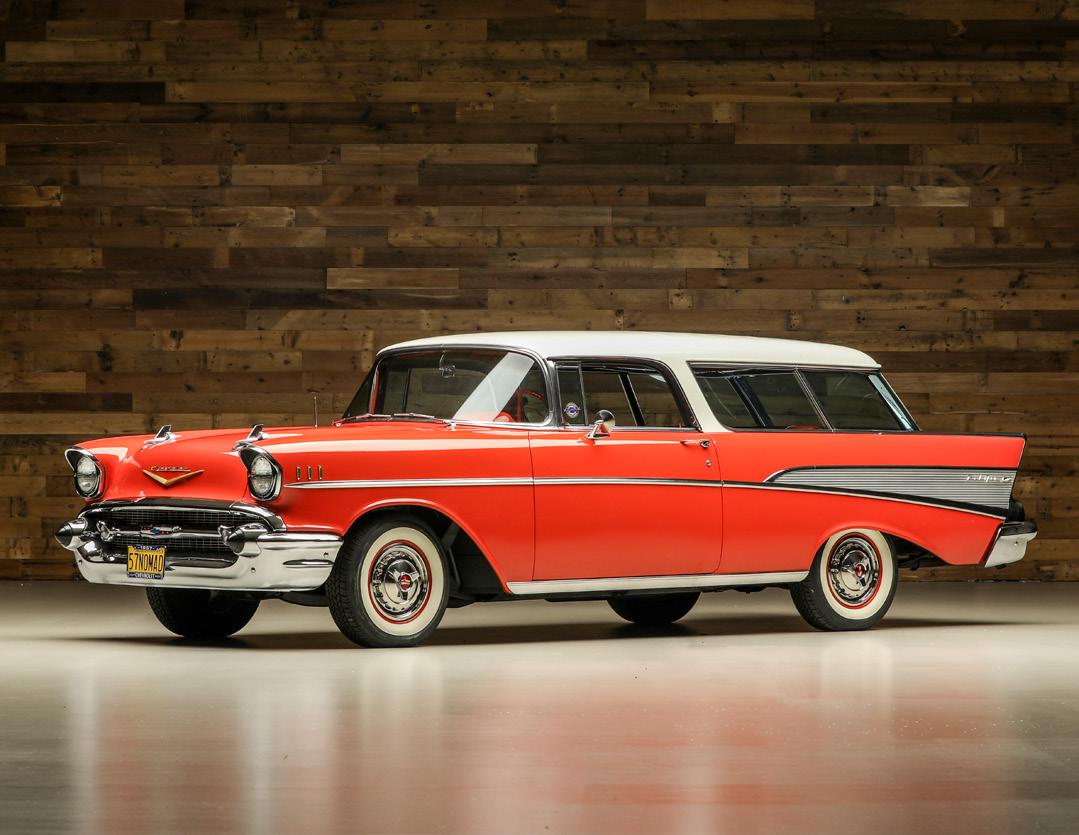

• Meticulously restored in original color of Matador Red

• Built to export specs but never left the country
This lot is available for online bidding at WorldwideAuctioneers.com
VIN: RM21J8A217494
• Factory 426-cid Hemi V-8 engine, TorqueFlite automatic transmission
Over the years, concerned groups of parents have gone after companies that used cartoonish advertising figures or characters for directing the youth of the day toward bad habits, such as the recent ban on cartoons being used to advertise junk food. As far as we know, no one has ever come after Plymouth for its use of the cartoon character, the Road Runner. Back in the summer of 1967, Chrysler Sales and Marketing man, Gordon Cherry
• Muscle Car Review feature car, “Hot-Roddicus Supersonicus”
• Deluxe interior, “Dog Dish” hubcaps, Music Master AM radio
was home watching Saturday morning cartoons with his kids when the speedy little Road Runner came on screen with Wile E. Coyote in hot pursuit. They had been looking for a good name for Plymouth’s intermediate performance-oriented new entry to the market. Come Monday morning, Cherry presented the idea to his boss, Jack Smith, who liked the idea. Using the Road Runner met with some resistance from the executive committee and,
after lots of pleading, it was given the green light. A marketing deal was made with Warner Bros. for the use of Road Runner, with the likeness of Wile E. Coyote thrown in for advertising purposes – all that for a reported $50,000 payment. It was a genius idea, with Plymouth wanting to appeal to the younger generation, many of whom had grown up watching Road Runner as a hero of sorts, and the humorous ad campaign brought customers to showrooms resulting in 44,000 units being sold in its first season.
To create this muscle-bound four-wheeled bird, engineers started with the entry-level Belvedere coupe and then installed heavy-duty front and rear suspension parts. The 383 “wedge” V-8, already rated at a hefty 290 HP, was treated to a high-lift cam, high-performance heads, dual exhausts, and a fuel-thirsty four-barrel carburetor which added 40 horses. So economical were these first Road Runners, bucket seats and a console were not even offered as accessories. Only one optional engine could be ordered, the mighty 426-cid Hemi V-8. To complete the package, Plymouth reportedly spent $10,000 just on the development of the “Me-Meep” horn. This Road Runner was inspected by an authority within the world of Mopar muscle and he determined that this particular Road Runner had originally been designated as an export car. However, it has never left the U.S., and is reportedly the only Roadrunner with this interesting history. Restored in the early 2000s, it was finished in its

original Matador Red with the deluxe two-tone vinyl bench seat. Restored to factory specifications, nothing was overlooked. Mounted in the dash is the push-button Music Master AM radio plus the lever-operated heater and defroster. Steel wheels painted to match the body are fitted with base hubcaps, a sign of being a performance vehicle of the highest caliber.
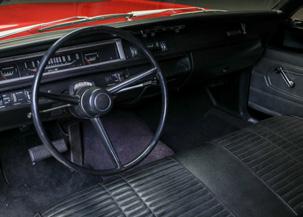
Keeping with the less is more theme, the car is riding on a set of Firestone F70 X 15” blackwall tires. Open the hood and the engine presents as a wonderful piece of art with a chrome air-filter housing, blank crinkle finish on the head, a properly painted block, and its accessories; everything is correct down to the tan distributor cap. Even the trunk is finished sporting the proper jack and wrench and a vintage red-line tire on a finished wheel. The undersides of the car are just as clean and fresh as the day it was assembled. According to the original fender tag, this Road Runner left the Lynch Road plant in Michigan on January 23, 1968, and its original owner must have fallen in love. Its authenticity has been decoded and verified and it is included in the Chrysler Registry. Plus, in the July 2008 issue of Muscle Car Review, it was featured in a multi-page article titled “Hot-Roddicus Supersonicus”. While this perky Plymouth is 55 years old, we would wager it will still get up and give that old coyote a run for his money and come out far in the lead. Don’t let it get away from you.

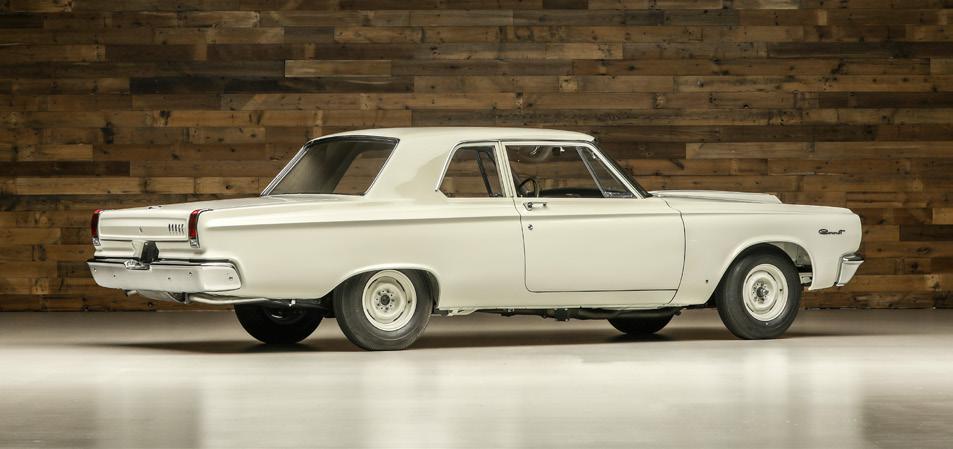
• Correct date-coded Hemi V-8
• A long list of deleted weight-saving items
• Well-documented with original IBM card, MSO and purchase order

• Shortened wheelbase
This lot is available for online bidding at WorldwideAuctioneers.com
VIN: W051252075
• Acid-dipped body panels, Corning lightweight glass
Chrysler allowed the development of its Hemi engine for one real purpose, to win races. However, NASCAR in 1964 decided that Chrysler's engine was not acceptable on their racetracks. Plan B was to build a factory car that would dominate the stock classes in NHRA-sanctioned drag racing. Thus, was born the era of “A990” Super Stock cars. A total of just 102 Plymouth Belvederes were produced and only 101 Dodge Coronets, one of which we are
• Original radiator and exhaust system
honored to offer. First, each engine was hand-assembled and fitted with many unique features such as a magnesium intake manifold topped with specially tuned Holley carburetors, special aluminum heads (which saved 80 lbs. over the factory cast iron units), and aluminum water pump housing. Saving weight was the number one goal with the development of these cars. The specially built TorqueFlite automatic transmissions were created
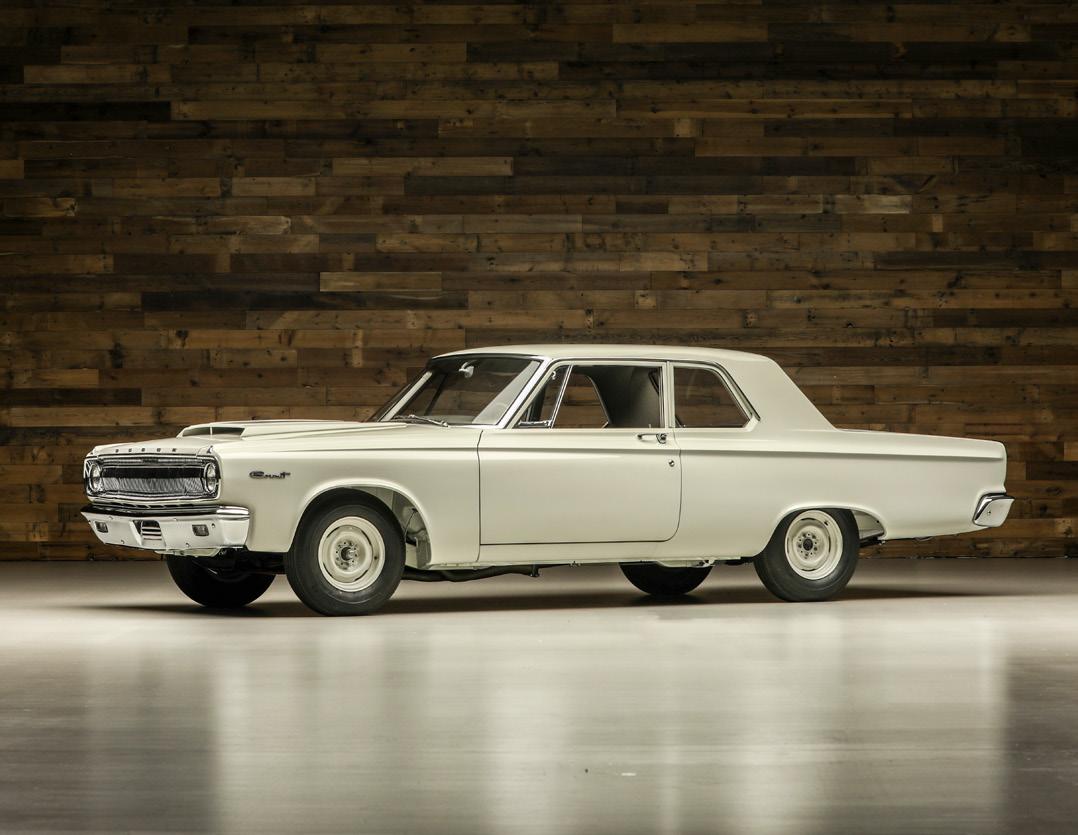
with a manual valve reverse shifting pattern, the deletion of the parking pawl, and a tail shaft housing found only on these transmissions. To the rear, the 8 ¾-inch axle was installed with 4.56:1 gears and they could withstand the tremendous amount of torque being sent to the rear wheels. To reduce weight, NASCAR would not allow special body panels of fiberglass or other lightweight material so all of the sheet metal was treated to an acid bath to shave off a few ounces. The side glass was replaced with Corning lightweight glass and, while the front door window still operates by hand crank, the rear windows were fixed in place. Bucket seats were sourced from the A100 vans, and any unnecessary components were eliminated including armrests, heater, radio, outside rearview mirrors, and even the sill plates and step guards as well as the entire back seat including seat belts. A lightweight carpet was installed but absolutely no undercoating or sound deadener was installed. To the front of the car, the high-beam headlights and all related hardware were deleted with a specially stamped grille designed to conceal the empty headlight opening. So desperate were the engineers to save weight, the back-up lights under the taillights were even deleted and replaced with special aluminum block-out plates. Other modifications included moving the battery to the trunk and special rear springs were drilled which allowed moving the rear axle two inches forward, which was considered as still being “stock” by NASCAR. A special exhaust system was used with the header pipes fitted with cut-outs and when not opened, fed the gases through a single pipe to the rear that was channeled through a specially

mounted transverse muffler.
This is one of those very special Super Stock Dodge Coronets that has been carefully inspected and restored to its original configuration. According to the original fender tag, it was painted white at the Lynch Road factory. The serial number starting with “W0” was used only on the Super Stock cars; it is a badge of honor. Close inspection of this Dodge will find that mounting holes under the hood for the battery were never used, same for splash guards and sill plates. Amazingly, this car was never tubbed-out or altered and retains all of its factory body panels, glass, radiator, exhaust system, and even the muffler. Front and rear bumpers have been replaced and replated. Much of the interior is also original though the door panels have been replaced. The Hemi engine is date-code correct and was completely rebuilt by Wheeler Racing Engines of Minneapolis. The chrome valve covers have not been restored and present their original finish and decals, which show a bit of patina. Many original items remain such as the Prestolite ignition and original steel headers which have been restored. The original owner filled the muffler with lead for added traction, so during restoration, the muffler was cut open and the lead removed, sealed back up, and is still beneath the car today. Both the 727 TorqueFlite transmission and rear axle are original to this car.
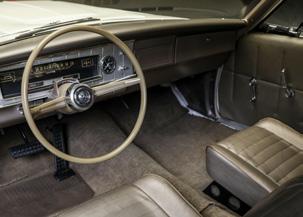
This Super Stock Dodge was delivered to Kolesar’s Garage in Westfield, Pennsylvania on April 21, 1965. It was sold to George McAndrews of Wellsville, New York, for the sum of $1,000 plus a trade-in of his near-new 1965 Dodge Coronet daily driver.

Because this car was not meant to be used on public roadways, it was never registered. As a result, the original Manufacturer’s Statement of Origin, or MSO, is included as will be the original bill of sale date April 16, 1965. In a handwritten letter from McAndrews to a subsequent owner in 1991, he stated, “No matter which drag strip we took it to, we always won.” McAndrews went on to claim it would run the quarter mile in the “low 10s” at around 134 mph. Another important piece of documentation with the car is its original IBM Build Card, which was professionally decoded.
This Coronet has been restored to its original condition; the only item we found that was probably added when new is a Stewart-Warner oil pressure gauge mounted in the dashboard to the right of the instrument cluster. The body was treated to a
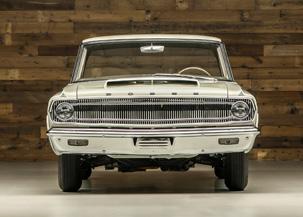
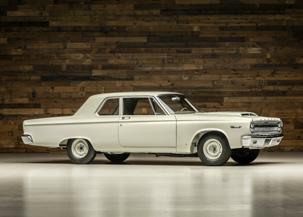
full rotisserie process which confirms that, despite its life as a competition vehicle, there were no signs of accidents. All body panels line up with the same care as when installed at the factory and the battery and full-size spare are mounted in the trunk. For those who would like to give the car the appearance of being race ready, the original velocity stacks and under-hood sheet metal are included in the trunk of the car. During ownership in the Thomas Haag Collection, this car was meticulously cared for. Of the 101 Dodge Coronet Super Stocks produced, only a handful have survived. It is believed that this example is the most factory-correct restoration and would be the centerpiece of any performanceoriented collection. Just for fun, imagine the thrill of being able to light those tires up just once.
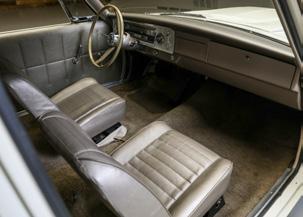
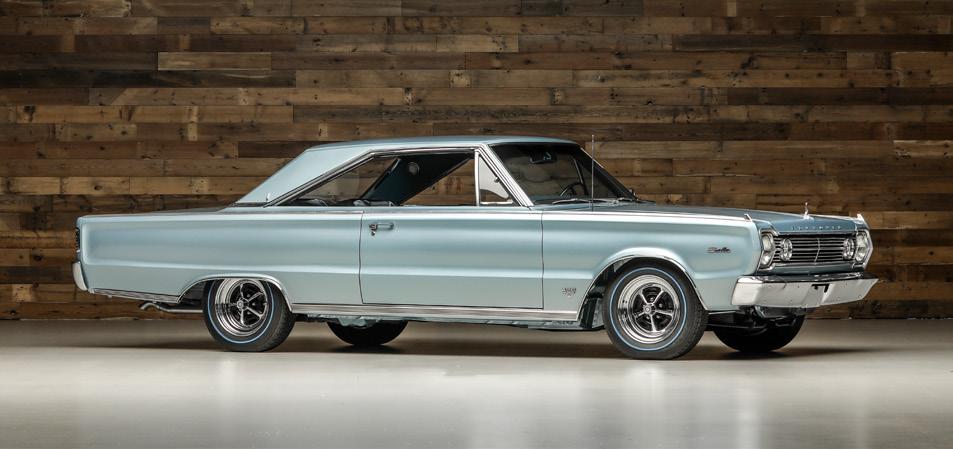
• No-expense-spared body-off-the-frame restoration

• Rare H-Code 426-cubic-inch Hemi V-8 engine
This lot is available for online bidding at WorldwideAuctioneers.com
VIN: RP23H67243885
• TorqueFlite automatic transmission and 3.23 Sure Grip rear axle
• Believed to be 1 of just 2 built with this combination
• Premium Satellite interior with bucket seats and console
Plymouth was Chrysler Corporation’s entry-level brand and in 1966 you could buy a compact Valiant or a full-size family sedan in the Fury family. In between was the Belvedere group of mid-size cars. Offered in three trim levels: Series I consisted of basic sedans and a wagon, Series II offered a full range of models for the modern
• Highly documented with the original broadcast sheet, Galen Govier decode paperwork, and letter from the Chrysler Historical Services
• Custom built, correct-component 426 Hemi, documented by motor build specs and dyno sheets
family, and then there was the sporty and somewhat elegant Satellite. Introduced in 1965, Satellites were offered in just two-door hardtop and convertible form and featured amenities such as bucket seats, center-shift console with or without tachometer, a selection of steering wheels, special wheel covers and so much
more. On the performance side, the 273-cid V-8 engine was standard with several larger V-8s as options. But for the performance-minded, there was the mighty H-Code 426-cubic-inch Hemi V-8. 1966 was the first time that Plymouth had coded the factory-installed engine in the car’s serial number and, that year, H was for Hemi. This beautiful Satellite two-door hardtop came out of the Pacific Northwest and entered Thomas Haag’s Toy Box in early 2015. Stunning in every way, this powerful Plymouth had been treated to a no-expense-spared top-shelf restoration. Finished in show-quality Light Blue Metallic, its original color, it included a base coat and clear coat with the same care given to the undercarriage as the exposed body panels. All chrome and bright trim work was restored or replaced, again to show-car quality. Interior appointments were brought up to new-car standards with premium color-coordinated vinyl coverings, bright chrome work, and fresh gauges. Extensive research was completed and a copy of the original IBM order card for this car was obtained from Chrysler Historical Services. The original fender tag confirms the Light Blue Metallic finish, as well as other items such as the interior, accessories, and the drivetrain which are very important to this car’s heritage. Seeking perfection in the build, this mighty engine was sent to Moffitt & Bratton Racing Engines in Boise, Idaho, where it was equipped with the
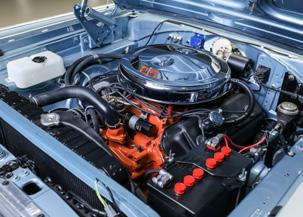

highest quality parts such as Diamond Pistons, a custom ground Erson cam, Edelbrock Performer carburetors, Wes King racing heads, and much more, all recorded in extensive detail on the included copies of the worksheets. After the engine was completed, it was sent to The Dyno Shop in nearby Nampa, Idaho where, with proper tuning, they were able to coax a reading over 479 HP at 5,000 RPM, producing nearly 484 lb-ft of torque at 4,700 RPM. After the engine was completed, it was mated to the 727 TorqueFlite automatic transmission with power sent to the rear wheels via the 3.23 Sure Grip rear axle. Magnum 500 style wheels are fitted with what appears to be a vintage set of blue-line tires and really set the theme for power, performance, and presence. With so much concentration paid to its performance, other accessories were kept to a minimum including the basic push-button AM radio and standard heater-defroster. Also included is a matching spare tire with factory jack and wrench, plus the owner’s manual, an album chronicling the build and testing of the Hemi-head V-8, receipts, publications, and two original broadcast forms. Acquired by Thomas Haag in 2015, as with the entire collection, this 1966 Satellite has been maintained in turnkey, ready-to-go condition and will present the new owner with opportunities to enjoy and share one of the finest Mopar muscle machines on the face of the planet.
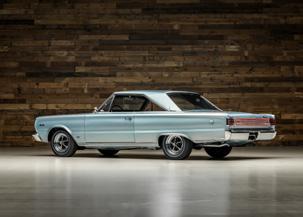
With the end of the 1931 Ford Model As, Henry Ford astonished the automotive world with the introduction of the first successful monobloc V-8 engine in a low-priced vehicle. It was a difficult time for bringing out a new car with the worsening financial disaster, but Ford was able to sell over 180,000 V-8 powered vehicles that year. Even so, Henry knew there would be those who still trusted his four-cylinder engines and had his staff work a number of improvements on the Model A engine. Introducing an oil passage below the valve gallery pressurized oil could be delivered to the main bearings, along with larger surfaces for bearings both of these adding to the engine’s power output and durability. Promoted as the new Model B, they delivered 25 percent more horsepower than the previous engine using the same displacement. All 1932
Fords also benefitted from stylish new bodies that E. T. “Bob” Gregorie had designed, which made the Model Bs a bargain. Offered in the same identical body styles as the V-8 cars, Model B buyers saved an average $45 over V-8 buyers, almost 10 percent of the cost of some models. As the thrill of open-air driving declined, open cars, especially the four-door phaetons fell in popularity with just 281 copies of the Model B Deluxe Phaeton being produced for 1932.
This example on offer from The Tom Haag Estate Collection was restored to exacting standards with the body painted in Ford’s Medium Maroon and handapplied red pinstriping added to the belt line. Gloss black fenders with a deep rich reflective quality are accented by the red wire-spoke wheels riding on a fresh set of Firestone 6.00” x 16” whitewall tires – quite chic in the
This lot is available for online bidding at WorldwideAuctioneers.com
• Rare body style; 1 of just 300 four-cylinder models built in 1932
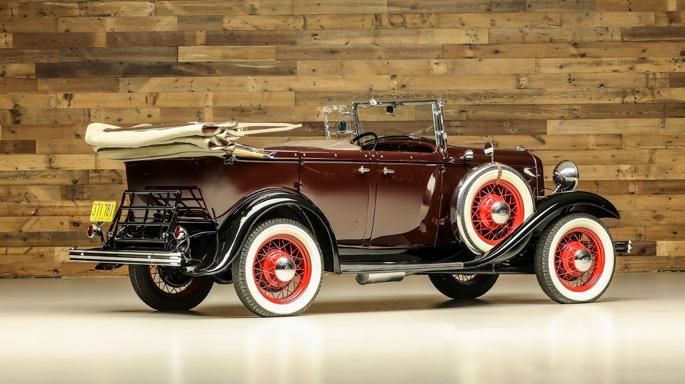
• Photo album documenting the body-off-the-frame restoration
• Original steel body with new steel fenders
• Rebuilt engine by Antique Engine in Skokie, Illinois

• Rebuilt drivetrain with high-speed rear end
• Attractive appearance with dual-side mounted tires with stainless covers
day. It is equipped with a vintage Sparton “OOO-GAH” horn mounted on the front left side of the chassis, and to offer the driver and passengers some protection, a pair of beautifully engraved wind wings. Dual side-mounted spare tires are mounted on the fenders, protected by bright metal bands, and dual taillights flank the optional trunk storage rack to the rear of the car. Fitted with a tan canvas folding top, which has a glass back window, the seats are done in pleated oxblood leather that is soft and supple to the touch. Under the hood, the engine appears to have been fully rebuilt, and while the electrical system has retained its 6-volt positive ground status, keeping the lights bright and the battery charged is a Nu-Rex alternator. Undoubtedly, the 1932 Ford styling is iconic and to find one restored to its original condition is rare and an opportunity not to miss.
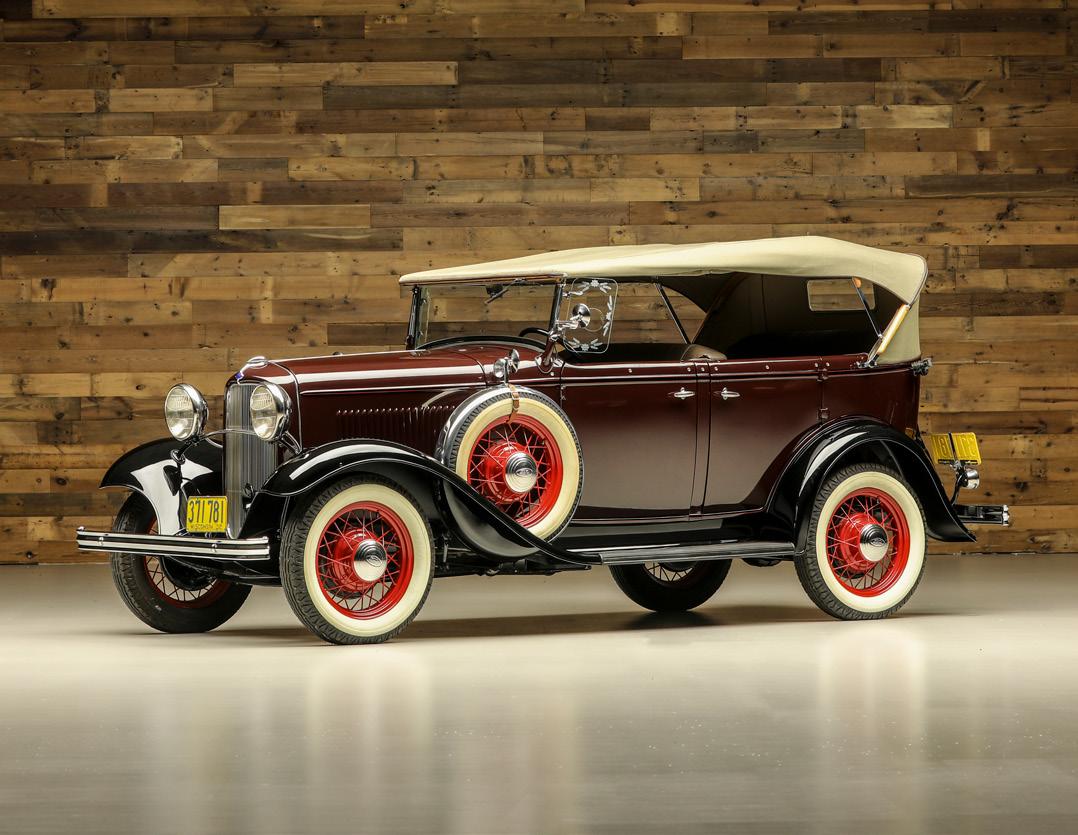
Business historians will tell you that in the years leading up to World War II, Ford Motor Company was in trouble. Old Henry had his ways, and while the company was busy producing some of the best-looking cars of the day and remained the only brand in the low-price segment with a V-8 engine available, it was awash in red ink. Edsel Ford, who was President of the company, did manage to retain the services of E. T. “Bob” Gregorie as the chief stylist for Ford, and his skill and expertise gave their cars a family look that was immediately recognizable. For 1941, Ford cars were offered in three trim levels: a Standard model, which was bare-bones motoring; the Super Deluxe, which had a bit of chrome and glitz; and the Deluxe, popular with families starting out or for the person who didn’t want to spend an extra $45 for chrome trim work and a bit plusher interior.
This example is 1 of 177,018 Deluxe Tudor sedans produced for the 1941 model year and is like a bit of a time capsule on wheels. Finished in its original basic black, the brown striped broadcloth seats do show a bit of age; however, they have stood up to the test of time and are still quite serviceable some 80+ years later. During the war, gas rationing made long trips out of reach for most Americans; as a result, many late pre-war model cars were just put up on blocks to wait out the war. Today, this fabulous Ford shows just over 24,630 miles on the odometer, which are believed to be actual. It is powered by its original flathead V-8 engine and remains in running and driving condition to this day. It is rather well-appointed with a factory radio and deluxe heater. According to the paperwork included with the car, this 1941 Ford has been part of the Haag Collection
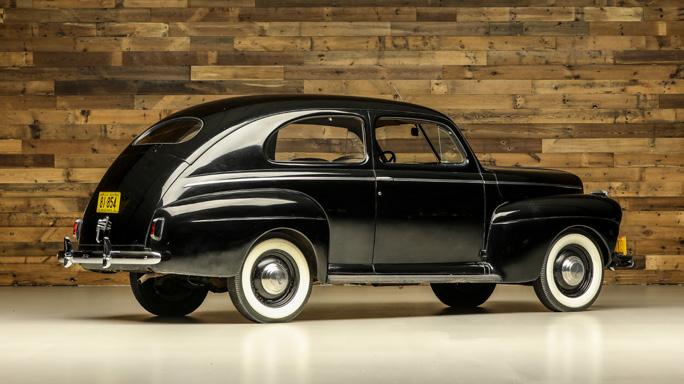
This lot is available for online bidding at WorldwideAuctioneers.com
• Totally unrestored, well-preserved original

• Big V-8 power in a mid-range model
• Seldom seem early V-8 engine
• Turnkey and ready to roll
since 1974. In 2012, according to receipts, Thomas Haag ordered a laundry list of new parts for this car including fuel system items, such as a carburetor rebuild/repair kit, new electrical items for the ignition system, cooling system items, and brake parts including a new master cylinder. At about this same time, he also ordered a set of Firestone 6.00” X 16” whitewall tires on which the car sits today. These receipts are part of a file that accompanies the sale of the car. The engine retains its original oil bath air cleaner and has an accessory bolt-on oil filter. Most impressive under the hood is the set of trumpet horns, sure to alert motorists who are getting too close to your classic Ford to stay away. A rolling time capsule with unique features such as the vintage Santa Catalina Island windshield decal, makes this a jewel to be admired and preserved for generations to come.
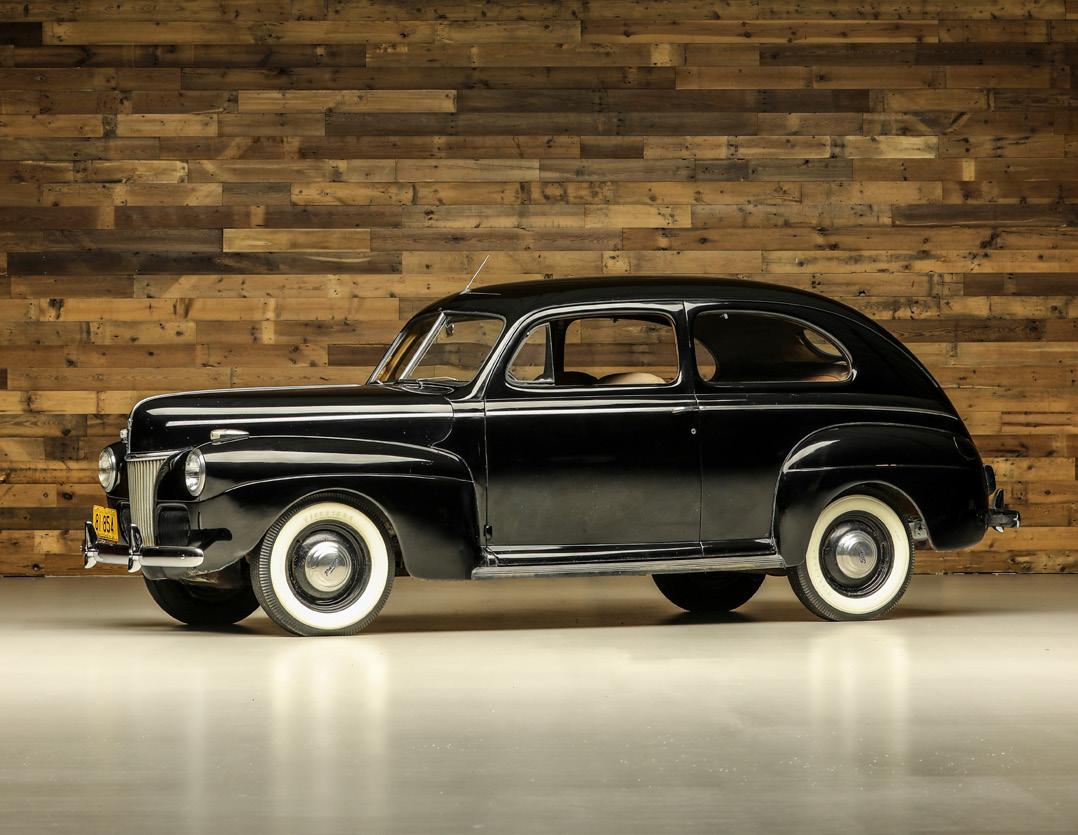
• Beautiful body-off-the-frame restoration finished in two-tone Kenya Ivory and Fontaine Blue

• Four-speed Hydra-Matic automatic transmission
This lot is available for online bidding at WorldwideAuctioneers.com
VIN: P857H33191
• 1 of just 630 fuel-injected Bonneville Convertibles built in 1957
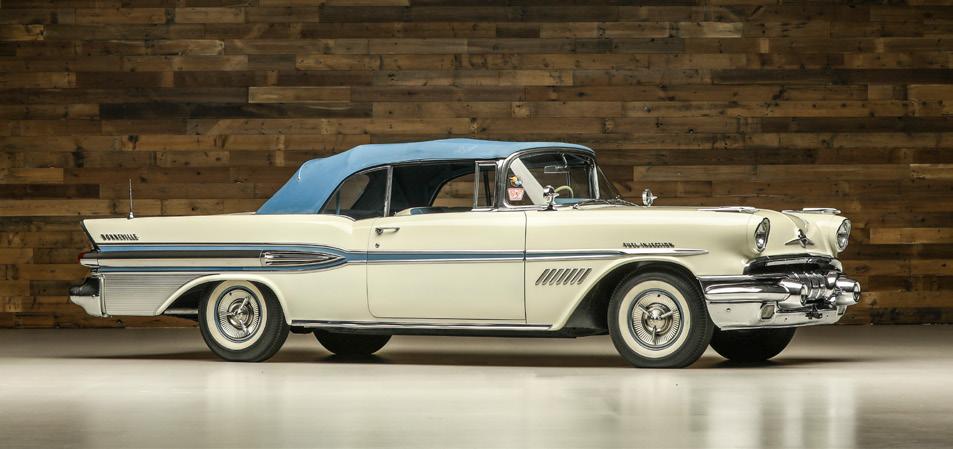
• Equipped with the 347/310 horsepower V-8 engine
During the 1950s, everyone wanted the latest and the greatest, and car companies were working hard to quench this unquenchable thirst for new. In 1955, Pontiac introduced its first overhead valve V-8 engine and, by 1957, it was already regarded as a pretty potent performer. But Pontiac had a reputation of designing cars for grandparents to drive. It was a step up from Chevrolet, but
• Thoroughly equipped with power steering, power brakes, power convertible top, power windows, power bench seat, tissue dispenser, factory clock, and Wonderbar AM radio
not quite to “Rocket 88” territory or as prestigious as a Buick or luxurious as a Cadillac. Semon E. “Bunkie” Knudson who took over the reins at Pontiac in the fall of 1957 wanted to change the brand’s image, often quoted as saying, “You can sell a young man’s car to an old man, you can’t sell an old man’s car to a young man!” Thus, work on a new showpiece was created. Initially, it was announced that
only one Bonneville convertible would be offered to each dealer, a number around 1,500 at the time. In the end, just 630 of these superior Pontiacs came off the assembly line. Standard on each car were power steering, power brakes, power windows and power front seat, and as all Bonnevilles were to be convertibles, a power top. Fine materials would be used such as hand-buffed leather seats, plush carpets, deluxe wheel covers and special badging. Under the hood was the big news, as this was the first fuel-injection system offered on a Pontiac from the factory. Developed by Rochester, a GM subsidiary, this unit bore no resemblance to the injection unit they were producing for Chevrolet. Bonneville was to be limited in numbers built and in colors available. Apparently, the most popular color combination was Kenya Ivory with Bonneville Red. According to a 2012 Authenticity Manual for these cars, a little more than 100 examples of these highly sought-after Bonnevilles were known to exist.
Finished in Kenya Ivory with Fontaine Blue two-toning in the side spear, this is one of the finest examples of the remaining Bonneville convertibles. Matching the exterior color scheme, the handbuffed leather seats are also in blue with white accents and most special was the blue folding soft top with matching boot. In addition to all of the power equipment which was standard, such as
windows, seat, steering, brakes and the top, this example is also fitted with the Electra-Matic signalseeking radio, often referred to as the Wonder Bar radio, optional color-coordinated seatbelts for front and rear seats, plus a nifty under-the-dash tissue dispenser.

This was one of the last cars to come to Thomas Haag’s Toy Box collection, acquiring it in early 2020. This sleek Bonneville appears to have been treated to a top-shelf body-off-the-frame restoration where no detail was overlooked, and no short cuts were allowed. The application of the paint appears to be flawless, and the interior looks fresh and new, down to the proper style of carpeting on the floor. All of Bonneville’s standard features are in place and the under-hood appearance is factory fresh. Upon hearing this car start up, that mighty V-8 comes to life. Pontiac Bonneville convertibles are truly legendary. As special as they were when new, most of the original factory documentation seems to have been lost to the ages. Pontiac never officially released any performance information on the Bonneville’s power output with all published records being based on independent tests. The Bonneville helped to transform Grandpa’s brand into a performance machine just as Knudsen had hoped and this car was part of an era when Pontiac started to build excitement.



• Built as a father and son project
• Exquisite Barcelona Blue paint, custom leather interior
• Street Scene magazine feature car
• Sacramento Autorama
1st Class Award 2008 & 2011
• 2009 NSRA Reps Pick, Sacramento
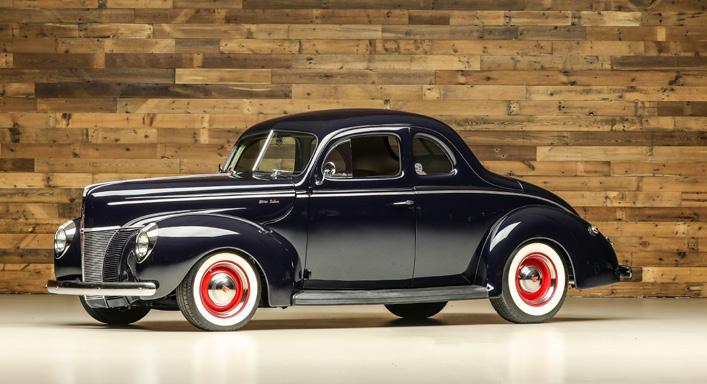
1940 Ford coupes have been a favorite with rodders and builders since the ‘50s, and this is one of the finest we have ever seen. It was constructed in the early 2000s starting with a solid original body and chassis and creating a most special ride. Created by Tim Bedford Jr. of northern California, this young man had some big shoes to try and fill as his father, Tim Bedford Sr. was well-known for his own awardwinning ’40 Fords. With encouragement and some technical expertise, this father and son team worked together on this fabulous build.
Following in his father’s footsteps, the body was removed from the original chassis, after having taken off the fenders and hood. Each piece was worked over and any flaws were remedied. The chassis was treated to a full restoration finished in gloss black
to which the new front suspension was installed, starting with a Panhard bar kit paired up with a set of custom wishbone style A-arms. Disc brakes were applied to the front wheels, while the rear used an upgraded drum brake setup. Ford’s original transverse leaf springs were upgraded to a custombuilt leaf spring setup and the use of a later model Ford rear axle. Once the metalwork for the body and accessory parts were smoothed to perfection, the dark, almost black shade of Barcelona, was applied while the interior was treated to a complete makeover using the finest leathers in beige for the seat coverings and door panels. With the installation of a rebuilt dashboard featuring a matched set of VDO gauges, an Ididit tilt steering column with a modern “banjo” type steering wheel, and finally a
modern R134A air-conditioning unit. Under the hood, a Chevrolet 350-cubic-inch V-8 was installed and fitted with a polished alternator, aluminum intake manifold and finned valve covers, and attached to a rock-solid Turbo-Hydramatic transmission; the car was ready to be shown.
It did both father and son proud taking top honors at several Northern California shows and the father-son build was featured in a Street Scene magazine article. Since its acquisition by Tom Haag, this gorgeous coupe has been constantly wellmaintained and shows just over 1,500 miles since the build was completed in 2008. When you get behind the steering wheel of this sleek 1940 Ford, you will know what it is to enjoy the finest quality workmanship and superb engineering.
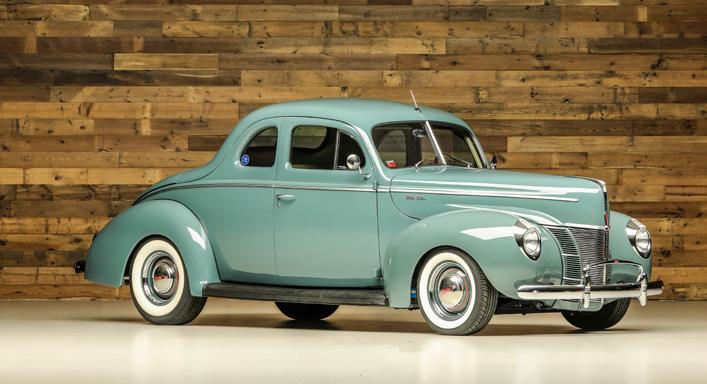
By the time Tim Bedford built this stunning 1940 Ford Model 67B Deluxe Business Coupe, his whole family had gotten into the spirit. His son, Tim Bedford Jr. followed in his father’s footsteps with his own awardwinning builds, and whenever Senior would unveil his latest ride, others came and critiqued the latest 1940 Ford from the Bedford clan. From the sharply pointed prow to the curvaceous roofline, on their own, those coupes were a work of art when new. After the Bedford touch, they were a thing of beauty and perfection.
Tim liked to call this car “Sneaky Pete”, fairly stocklooking in appearance but completely modern in performance. Starting with a 1978 Camaro Z28 block, he had it balanced and blueprinted polished finned aluminum valve covers and Edelbrock intake manifold, Petronix electronic ignition with stock distributor, heat
coated headers, 12-volt electrics with alternator and modern R134A air-conditioning. During the build, no holes were cut, and no hoses were visible; it is like Tim says, “Sneaky”. Starting with an original all-steel body and fenders, it was refinished in what Ford called “Cloud Mist Gray”. In reality, it was a pleasant medium green that was so popular when this coupe was new. Original style trim was used in the build to maintain that stock appearance. Underneath, the original frame was retained given many modern upgrades from the rear-axle setup to the four-inch dropped axle, an original 1940 Ford sway bar with Heim joint end and a disc brake conversion that look pretty stock.
While the exterior looks 1940, wait until you look inside; you have to look twice to see the little differences. Starting with the dash, Tim handcrafted modern gauges
This lot is available for online bidding at WorldwideAuctioneers.com

• Award-winning build
• Part of a father-son building duo
• Superb fit and finish, nothing less than perfection
• Built on an original 1940 Ford chassis
• Well-documented build with extensive photo album
• Stock appearance, modern performance
using original style faces giving the dashboard the look of 1940, but operating like a modern sports car. The seats are upholstered in supple tan leather with matching top-shelf quality vinyl trim for the door and other inner panels. Even the carpet, a high-grade German squareweave wool carpet was installed in the passenger cabin as well as the luggage compartment. The stockappearing radio faceplate flips up to reveal a concealed audio system with CD player and satellite radio receiver. The heating and cooling system is also concealed, and it was no “kit” item; this was Tim Bedford creating and engineering his own design. Tim built a number of 1940s Fords during his reign as one of the top builders from California, and he kept “Sneaky Pete” around the longest before selling it to Tom Haag simply because Tim's wife liked it the best. We think you will love it too.
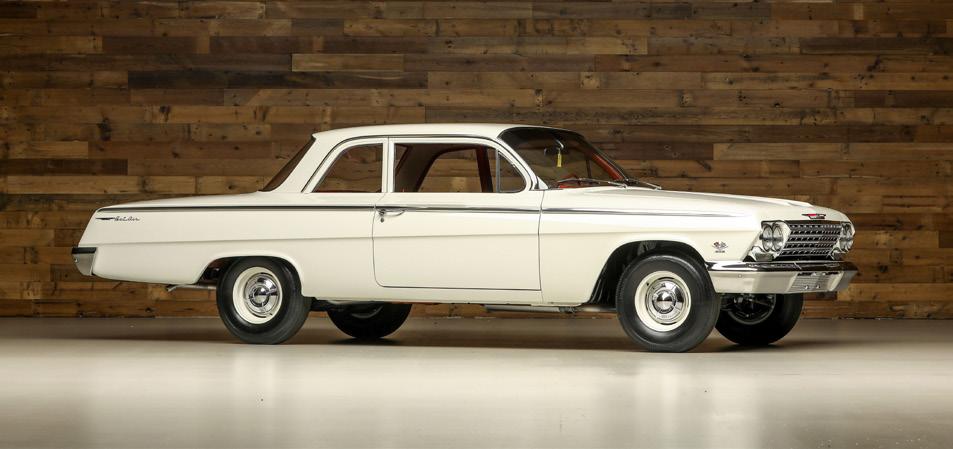
• Concours quality restoration

• High-performance perfection
• Legendary street-legal rocketship
• Numbers matching engine block
This lot is available for online bidding at WorldwideAuctioneers.com
VIN: 21611K156759
• Authentic and proper parts, materials and finish
1962
was a banner year for Chevrolet, one in which the company celebrated its Golden Anniversary and did very well in the area of motorsports. Strong customer appeal made Chevy the winner in the sales race also, and the big-block Turbo-Jet 409 V-8s opened an era of full-size performance. At the 1962 NHRA Winternationals in Pomona, California, the final showdown pitted “Dyno” Don Nicholson facing off against Dave Strickler, both of
them driving 409-equipped Chevrolets. “Dyno” Don did a repeat of his 1961 performance taking home the championship for both himself and Chevrolet. That win might have helped fuel the reported 15,019 “W” series 409-cubic-inch big-block Chevrolet engines produced that year. 8,909 of those were sent to assembly plants for installation in new cars, while the remaining 6,100 plus were ordered by dealerships as either a service replacement or
as crate motors. In 1962, thousands of car-crazy teens learned all the values of Chevy’s big 409 V-8 thanks to the Beach Boys who in their song would immortalize this powerful engine, for it was so fine. For 1962, full-size Chevrolets were offered in three trim levels, the Biscayne for fleet owners and budget-conscious buyers, the Impala for those who wanted a lot of glitz and chrome trim, and the Bel Air which featured well-appointed basic sedans and a hardtop, and were often the recipient of one of these mighty engines. In quarter-mile competition, the Turbo-Jet V-8 provided an extreme amount of body twisting torque, so to combat body flex and provide better stability on the track, the two-door post sedan was the racer’s choice.

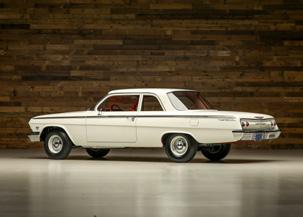
This superb two-door sedan was originally assembled at Chevrolet’s Kansas City facility in Missouri. While the details of its early life are not known, the quality of the finished product reveals that this must have been a solid car when the restoration was started. Today the majestic big-block V-8 engine, with the numbers matching engine block, looks fresher than it did when originally installed in this car back in March 1962. The dual Carter AFB carburetors are clean and fresh with the entire engine bay presented in show-car condition. Nothing was overlooked including the factoryapplied stickers and even the radiator warning tag. Behind this massive engine is the Borg-Warner T-10
four-speed transmission connected to a Positraction rear axle. Affixed to the firewall is the original build tag showing paint color 936, indicating it left the plant in Ermine White. The same tag shows interior trim code 872 indicating the red vinyl and fabric interior. During the restoration, strict attention to detail was paid to even the little items and Seville grain vinyl was used for seating surfaces and door panels. There are a few accessory items such as the tinted windshield, padded instrument panel, heater-defroster, two-speed windshield wipers with washer system, back-up and luggage compartment lights plus the outside rearview mirror and inside non-glare mirror.
Bodywork is exceptional on this car as is the flawless paint and excellent bright trim. All underbody surfaces were restored with red oxide primer while the chassis was finished with its proper black finish. A new exhaust system looks like it is right off the shelf and even the fuel tank is clean and shiny. A set of BFGoodrich 8.00 X 14” black sidewall four-ply tires grace the restored steel wheels adorned with basic hubcaps. The odometer reads just under 26,500 miles which could be from when this Bel Air was new; however, the true mileage is unknown. We invite you to carefully inspect this beautiful car and if perfection is what you are looking for, there will be no need to look any further.

This lot is available for online bidding at WorldwideAuctioneers.com
• Beautiful restoration
• Economical and easy to park

• Sunroof edition
• Tight-fitting body with room for two
Renzo Rivlota was a brilliant engineer who headed up Isothermos, a major refrigerator company in Italy. In 1953, he developed the idea of building a small vehicle that would be an ideal around-town car. It was designed to carry a driver and passenger, be economical to buy, cheap to own and easy to maintain. Revealed at the 1954 Geneva Auto Show, the Isetta or “Little Iso” was unveiled, and great interest followed. They were somewhat practical and wellengineered and, in 1955, several Isettas took part in the Mille Miglia, easily winning their class. Seeing an opportunity to provide jobs and raise capital, BMW applied for and was granted a license to build the little car. Iso even provided much of the specialized tooling needed to get production rolling. In April 1955, BMW began production at their headquarters in Munich and keeping up with demand was a priority. BMW re-engineered much of the car, making it a
four-wheeler and offering an optional, larger 300cc engine. Isettas would also be built under license in several other countries such as England, France, Argentina and Brazil. In 1963, one daring West Berliner, used his Isetta to smuggle his boyhood best friend out of East Berlin by hiding him in the engine compartment of his Isetta. With over 220,000 examples produced, they were exported all over the world and in the 1990s an Isetta became a fan favorite of the TV show “Family Matters” when lead character Steve Urkel drove one in several episodes.
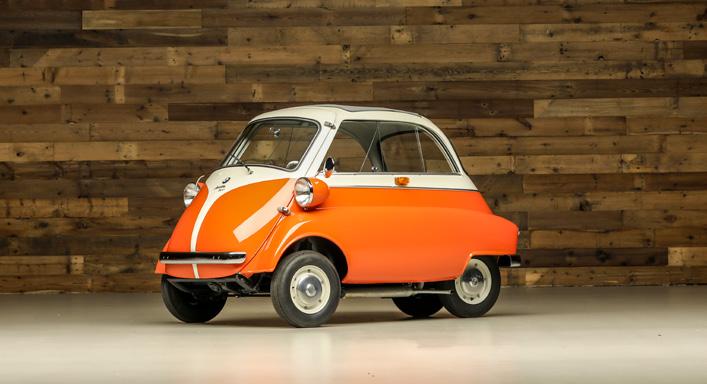
Euphemisms such as “cute” or “adorable” apply to this fun little machine, and the example being offered from the Haag Collection fits those descriptions perfectly. Finished in a pleasing combination of orange and crème, this little car’s bench seat and interior side panels are presented in grey vinyl and the easy-opening sliding sunroof in a dark grey
material. It is also equipped with sliding side windows for ventilation or to wave to friends. The single-cylinder engine has been restored and starts easily. The original build tag clearly identifies this car as a U.S. import model but has been updated with European-style amber side clearance lights. Able to attain speeds of up to 50 mph, fuel consumption is said to be about 50 miles to the gallon with the tank designed to hold 3.2 gallons of fuel.
This sharp little coupe was acquired by the Haag Collection in the summer of 2019 and was immediately placed into the famous Toy Box for all who visited to admire. Maintained and ready to tour, it was used on just a few occasions and remains in pristine condition. Included is an original Instruction Manual printed in Spanish, French and English. If you have ever wanted a car that would steal the show and attract plenty of attention, this little Isetta will do the trick.
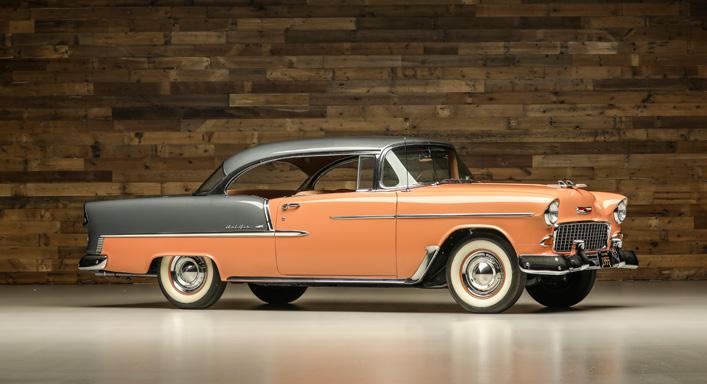
Early 1955 saw new base V-8 motors from each of the “low-priced” three, Plymouth with 241 cubic inches rated at 157 HP, Ford with an enlarged Y-block at 272 cubes rated at 162 HP, and Chevrolet with its 265-cid V-8 with two-barrel intake also rated as 162 HP. Fans of any of these marques might have considered their engines to be the best, but the engineering and design of Chevrolet’s small-block V-8 was developed under the guidance of a pure genius, Ed Cole. Combined with the all-new styling of the 1955 Chevrolet, plus a completely new chassis, it is no wonder that Chevy would take the lead in the sales and production numbers for the recordsetting year. Offered in three trim levels, the Bel Air was the smartest-looking of the trio. Featuring six body styles, including two station wagons, more
buyers than ever before stepped up and took home the beautiful hardtop. From the Ferrari-inspired egg-crate grille up front to the smooth and built-in look of the handsome mini-cathedral taillights, from every angle, the 1955 Chevrolets were miles ahead of the competition.
Looking at this stunning Coral and Shadow Gray 1955 Bel Air two-door hardtop, you will know why over 185,562 of these cars went to new owners. This fine example was produced at Chevrolet’s Kansas City facility and, according to the original build tag, it came exactly as it is presented today – with a color scheme both inside and out, that says, mid-century modern at its best. Treated to a full restoration, everything is proper from factory style vinyl grains, with the charcoal and ivory straw pattern fabrics,
VIN: VC55K050948
• Trendsetting styling
• Finished in attractive Coral and Shadow Gray Poly
• 265-cubic-inch V-8 engine paired with an automatic transmission
• Restored to original specifications
to all of the appointments such as push-button radio, heater-defroster, back-up lights, dual exhaust, and little things like the fingernail guard for the fuel door, bright rocket panel moldings, under-dash tissue dispenser, and the unique Guide Traffic Light Viewer. The workmanship is top-shelf all the way on this car, with excellent body panel alignments, doors that open and close with ease, and under-hood detailing showing off that wonderful V-8 engine, complete with the oil-bath air cleaner. Full optional wheel covers accompany a set of 6.70” X 15” wide whitewall tires that look fresh and new. With the turn of the key, this Chevrolet comes alive and, with you behind the wheel, you too can experience the thrill of seeing the USA in your new Chevrolet.



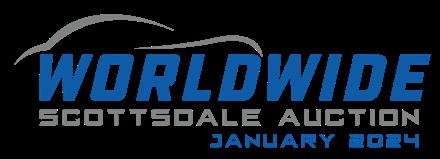



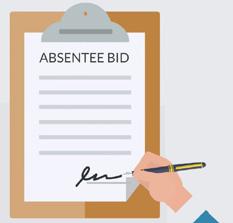


Finding the perfect collector car you have been waiting for is a process that should be fun and exciting from beginning to end. At Worldwide Auctioneers, we guarantee just that.
We truly care about you and your car. From bidder registration to previewing cars to auction day, you can expect to feel like a VIP guest the moment you engage with us.

There’s nothing that makes us smile more than watching you drive off with the car of your dreams. Get started today by registering to bid.



